Paul van Yperen's Blog, page 60
February 5, 2024
Don Murray (1929-2024)
On 2 February 2024, American actor Don Murray (1928-2024) passed away at his home in Goleta, California. He was best known for his breakout performance in the film Bus Stop (1956), with Marilyn Monroe. His role earned him a nomination for the Academy Award for Best Supporting Actor. His other films include A Hatful of Rain (1957) and Conquest of the Planet of the Apes (1972). Murray was 94.
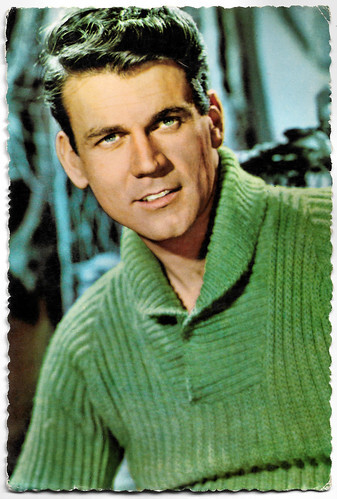
Spanish postcard by Raker, no. 1050.
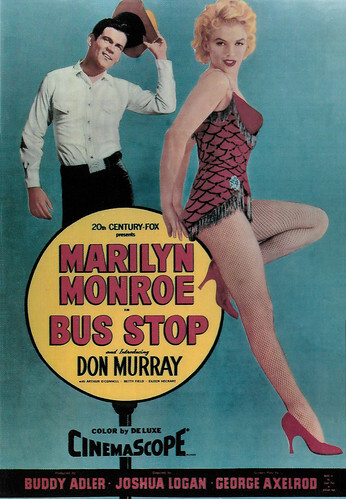
American postcard by Classico San Francisco, no. 110-006. Image: 20th Century Fox. American poster of Bus Stop (Joshua Logan, 1956) with Marilyn Monroe and Don Murray.
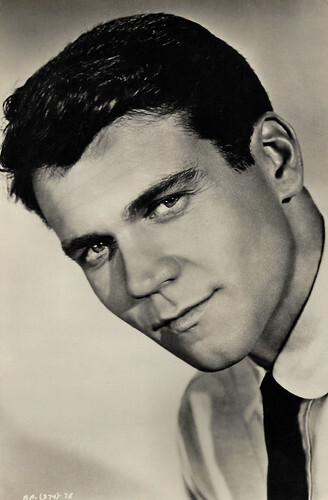
Spanish postcard by Archivo Bermejo, no. 7317. Photo: 20th Century Fox. Don Murray in A Hatful of Rain (Fred Zinnemann, 1957).
A naive, overly enthusiastic, and socially inept cowboy from Montana
Donald Patrick Murray was born in 1929 in Hollywood, California, to Dennis Aloisius Murray and his wife Ethel Murray née Cook. Dennis worked as a dance director and stage manager, while Ethel was a singer who had performed in the Ziegfeld Follies on Broadway. Don attended the East Rockaway High School in East Rockaway, a village in Nassau County, New York.
During his high school years, Murray served as a member of the school's football team, its track team, and its glee club. He graduated in 1947, at the age of 18. He later attended the American Academy of Dramatic Arts in Manhattan, New York where he graduated in 1951. Murray made his Broadway debut as Jack Hunter in 'The Rose Tattoo' (1951) by Tennessee Williams. In the play, Hunter is a sailor and the boyfriend of Rosa Delle Rose, the daughter of the play's female protagonist.
Murray's stage career was interrupted when he was drafted into the United States military. He registered as a conscientious objector during the Korean War (1950-1953), as he was a member of the Brethren Church, an Anabaptist Christian denomination, which strictly adheres to pacifism and non-violence. Murray was assigned to an alternative service in Europe. He was honourably discharged from the military in 1954 and resumed his acting career. He starred alongside Mary Martin in the stage version of 'The Skin of Our Teeth'.
Upon seeing his performance in the play, director Joshua Logan decided to cast him in 20th Century Fox's film adaptation of 'Bus Stop', a play by William Inge. Murray made his film debut opposite Marilyn Monroe in Bus Stop (Joshua Logan, 1956), as Beauregard "Beau" Decker, a naive, overly enthusiastic, and socially inept cowboy from Montana. The film depicts Beau's infatuation with young singer Cherie (Monroe), which causes him to first kidnap her and then coerce her into marrying him. He is tragically unaware that Cherie barely knows him, and that his love is unrequited. The film was a box office success, and Murray was nominated for an Academy Award for Best Supporting Actor. The Award for that year was won by Anthony Quinn , but Murray's successful debut led to more film roles.
He was cast as Charlie Samson in the drama The Bachelor Party (Delbert Mann, 1957) as a hard-working bookkeeper who struggles with the temptation to cheat on his wife. He was then cast as morphine-addict Johnny Pope in A Hatful of Rain (Fred Zinnemann, 1957), a film about the then-innovative topic of drug addiction. In 1958, Murray played in his first Western, From Hell to Texas (Henry Hathaway, 1958). He was cast as Tod Lohman, an impoverished ranch hand who is suspected of murdering the son of a powerful cattle baron. The film deals with Lohman being hunted by the cattle baron's other son and his mercenaries, who seek revenge. Murray's second Western was These Thousand Hills (Richard Fleischer, 1959), a rags-to-riches story about a man who betrays his lover and alienates his only friend to marry a banker's daughter for her money. Murray was also cast opposite James Cagney in a lead role in the war film Shake Hands with the Devil (Michael Anderson, 1959), which depicts the Irish War of Independence.
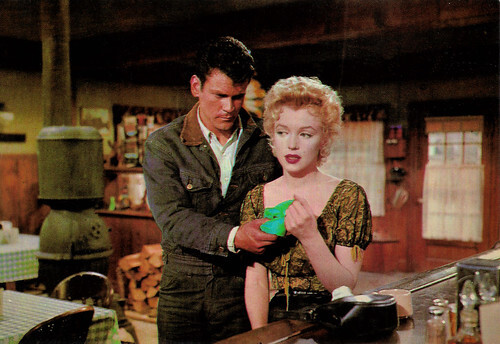
American postcard by Classico San Francisco, no. 105-018. Photo: 20th Century Fox. Don Murray and Marilyn Monroe in Bus Stop (Joshua Logan, 1956).
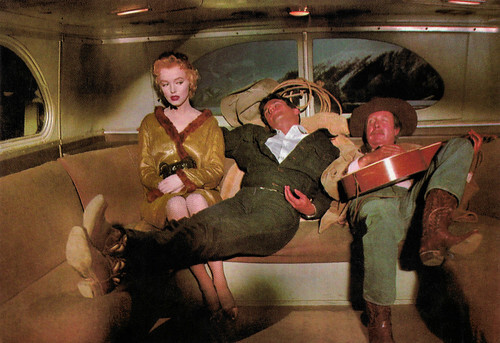
American postcard by Classico San Francisco, no. 105-019. Photo: 20th Century Fox. Marilyn Monroe , Don Murray and Arthur O'Connell in Bus Stop (Joshua Logan, 1956).
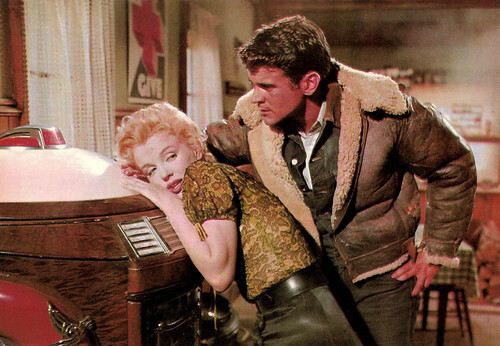
American postcard by Classico San Francisco, no. 105-022. Photo: 20th Century Fox. Marilyn Monroe and Don Murray in Bus Stop (Joshua Logan, 1956).
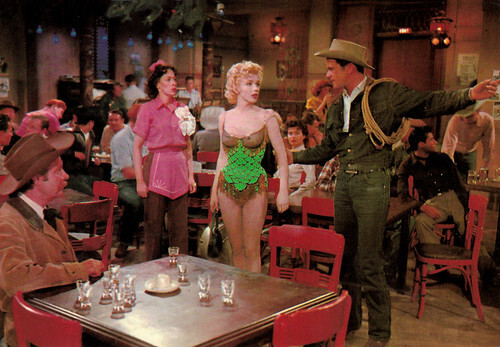
American postcard by Classico San Francisco, no. 105-023. Photo: 20th Century Fox. Arthur O'Connell, Eileen Heckart, Marilyn Monroe and Don Murray in Bus Stop (Joshua Logan, 1956).
A human civilisation using apes as a slave force
During the 1960s, Don Murray continued to appear regularly in films, often cast in period dramas. Murray starred as a blackmailed United States senator in Advise & Consent (Otto Preminger, 1962), a film version of a Pulitzer Prize-winning novel by Allen Drury. Murray starred opposite Henry Fonda and Charles Laughton . He also co-starred with Lee Remick and Steve McQueen in Baby the Rain Must Fall (Robert Mulligan, 1965). He played Wild Bill Hickok in The Plainsman (David Lowell Rich, 1966), and ambitious ruler Justinian in The Viking Queen (Don Chaffey, 1967).
In 1968, Murray gained a co-starring role in the Western television series The Outcasts (1968-1969). He played Earl Corey, an American Civil War veteran and formerly wealthy slave owner. In the series, Corey was cheated out of his wealth by a treasonous brother and started making a living as a bounty hunter. He teams up with fellow bounty hunter Jemal David (Otis Young), an African-American freedman. The two men are not friends, but they are both social outcasts and need each other's skills to gain a profit. The series was considered groundbreaking for featuring an interracial team of characters but was criticised for being overly violent. The series lasted only 26 episodes.
In 1972, Murray played Governor Breck in Conquest of the Planet of the Apes (J. Lee Thompson, 1972). Breck is the authoritarian ruler of a human civilisation using apes as a slave force, and he is the owner of the film's heroic protagonist Caesar. He eventually fails to defeat a slave revolt and gets captured alive by his slave. The film was a box-office success. Murray was offered the role of Breck in the sequel, Battle for the Planet of the Apes (J. Lee Thompson, 1973), but he refused to return. He reportedly felt that there was no fun in playing the tyrant twice. In 1975, Murray starred in the thriller Deadly Hero (Ivan Nady, 1975), as the villainous protagonist Officer Lacy.
In the late 1970s, Murray mostly appeared in television films. In 1979, he made a comeback as Sid Fairgate in the soap opera Knots Landing (1979-1993). Fairgate was depicted as the owner of the used car dealership Knots Landing Motors, and pater familias to a large family. Murray played this role until 1981 when he left the series due to a salary dispute. His character was written out as having died during surgery. During the 1980s, Murray had a few film appearances in Endless Love (Franco Zeffirelli, 1981) starring Brooke Shields, Peggy Sue Got Married (Francis Ford Coppola, 1986) with Kathleen Turner, and the fantasy Made in Heaven (Alan Rudolph, 1987). In 1989, Murray gained a new co-starring role in the comedy-drama television series Brand New Life (1989-1990), playing the character of wealthy lawyer Roger Gibbons. The series was not successful, and only a pilot and 5 regular episodes were ever broadcast.
For the rest of the 1990s, Murray had guest star roles in various television series and appeared in a handful of television films. He directed and starred in the comedy Elvis is Alive (Don Murray, 2001). In 2001, the then 72-year-old Murray retired, but he returned to acting in 2017 when offered the recurring role of insurance company executive Bushnell Mullins in the third season of the mystery series Twin Peaks (1990-1991, 2017). Mullins was the boss of insurance agent Douglas "Dougie" Jones, one of several doppelgangers to FBI agent Dale Cooper, the series' main protagonist. The season was critically praised but there were no plans for a fourth season. His final film was the Western Promise (Joe Cornet, 2021). Don Murray passed away in 2024 at his home in Goleta, California, at the age of 94. He was married twice. His first wife was actress Hope Lange (1956-1962) with whom he had two children, Christopher and Patricia. In 1962, he married Bettie Johnson with whom he had three children, Colleen, Sean, and Michael.
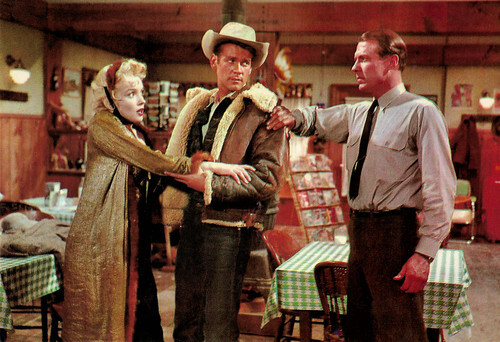
American postcard by Classico San Francisco, no. 105-024. Photo: 20th Century Fox. Marilyn Monroe, Don Murray and Robert Bray in Bus Stop (Joshua Logan, 1956).
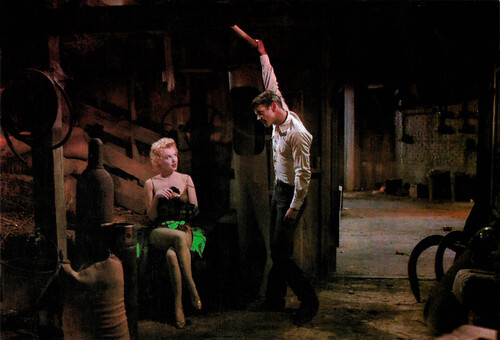
American postcard by Classico San Francisco, no. 105-025. Photo: 20th Century Fox. Don Murray and Marilyn Monroe in Bus Stop (Joshua Logan, 1956).
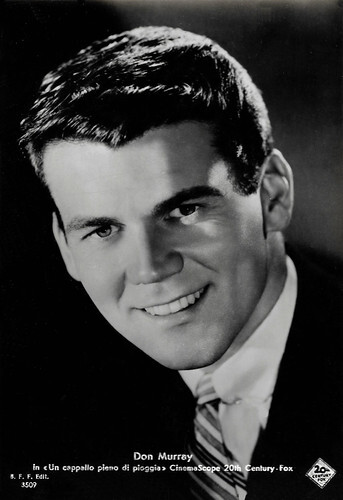
Italian postcard by Casa Editr. Ballerini & Fratini, Firenze, no. 3509. Photo: 20th Century Fox. Don Murray in A Hatful of Rain (Fred Zinnemann, 1957).
Sources: (IMDb), Wikipedia and .

Spanish postcard by Raker, no. 1050.

American postcard by Classico San Francisco, no. 110-006. Image: 20th Century Fox. American poster of Bus Stop (Joshua Logan, 1956) with Marilyn Monroe and Don Murray.

Spanish postcard by Archivo Bermejo, no. 7317. Photo: 20th Century Fox. Don Murray in A Hatful of Rain (Fred Zinnemann, 1957).
A naive, overly enthusiastic, and socially inept cowboy from Montana
Donald Patrick Murray was born in 1929 in Hollywood, California, to Dennis Aloisius Murray and his wife Ethel Murray née Cook. Dennis worked as a dance director and stage manager, while Ethel was a singer who had performed in the Ziegfeld Follies on Broadway. Don attended the East Rockaway High School in East Rockaway, a village in Nassau County, New York.
During his high school years, Murray served as a member of the school's football team, its track team, and its glee club. He graduated in 1947, at the age of 18. He later attended the American Academy of Dramatic Arts in Manhattan, New York where he graduated in 1951. Murray made his Broadway debut as Jack Hunter in 'The Rose Tattoo' (1951) by Tennessee Williams. In the play, Hunter is a sailor and the boyfriend of Rosa Delle Rose, the daughter of the play's female protagonist.
Murray's stage career was interrupted when he was drafted into the United States military. He registered as a conscientious objector during the Korean War (1950-1953), as he was a member of the Brethren Church, an Anabaptist Christian denomination, which strictly adheres to pacifism and non-violence. Murray was assigned to an alternative service in Europe. He was honourably discharged from the military in 1954 and resumed his acting career. He starred alongside Mary Martin in the stage version of 'The Skin of Our Teeth'.
Upon seeing his performance in the play, director Joshua Logan decided to cast him in 20th Century Fox's film adaptation of 'Bus Stop', a play by William Inge. Murray made his film debut opposite Marilyn Monroe in Bus Stop (Joshua Logan, 1956), as Beauregard "Beau" Decker, a naive, overly enthusiastic, and socially inept cowboy from Montana. The film depicts Beau's infatuation with young singer Cherie (Monroe), which causes him to first kidnap her and then coerce her into marrying him. He is tragically unaware that Cherie barely knows him, and that his love is unrequited. The film was a box office success, and Murray was nominated for an Academy Award for Best Supporting Actor. The Award for that year was won by Anthony Quinn , but Murray's successful debut led to more film roles.
He was cast as Charlie Samson in the drama The Bachelor Party (Delbert Mann, 1957) as a hard-working bookkeeper who struggles with the temptation to cheat on his wife. He was then cast as morphine-addict Johnny Pope in A Hatful of Rain (Fred Zinnemann, 1957), a film about the then-innovative topic of drug addiction. In 1958, Murray played in his first Western, From Hell to Texas (Henry Hathaway, 1958). He was cast as Tod Lohman, an impoverished ranch hand who is suspected of murdering the son of a powerful cattle baron. The film deals with Lohman being hunted by the cattle baron's other son and his mercenaries, who seek revenge. Murray's second Western was These Thousand Hills (Richard Fleischer, 1959), a rags-to-riches story about a man who betrays his lover and alienates his only friend to marry a banker's daughter for her money. Murray was also cast opposite James Cagney in a lead role in the war film Shake Hands with the Devil (Michael Anderson, 1959), which depicts the Irish War of Independence.

American postcard by Classico San Francisco, no. 105-018. Photo: 20th Century Fox. Don Murray and Marilyn Monroe in Bus Stop (Joshua Logan, 1956).

American postcard by Classico San Francisco, no. 105-019. Photo: 20th Century Fox. Marilyn Monroe , Don Murray and Arthur O'Connell in Bus Stop (Joshua Logan, 1956).

American postcard by Classico San Francisco, no. 105-022. Photo: 20th Century Fox. Marilyn Monroe and Don Murray in Bus Stop (Joshua Logan, 1956).

American postcard by Classico San Francisco, no. 105-023. Photo: 20th Century Fox. Arthur O'Connell, Eileen Heckart, Marilyn Monroe and Don Murray in Bus Stop (Joshua Logan, 1956).
A human civilisation using apes as a slave force
During the 1960s, Don Murray continued to appear regularly in films, often cast in period dramas. Murray starred as a blackmailed United States senator in Advise & Consent (Otto Preminger, 1962), a film version of a Pulitzer Prize-winning novel by Allen Drury. Murray starred opposite Henry Fonda and Charles Laughton . He also co-starred with Lee Remick and Steve McQueen in Baby the Rain Must Fall (Robert Mulligan, 1965). He played Wild Bill Hickok in The Plainsman (David Lowell Rich, 1966), and ambitious ruler Justinian in The Viking Queen (Don Chaffey, 1967).
In 1968, Murray gained a co-starring role in the Western television series The Outcasts (1968-1969). He played Earl Corey, an American Civil War veteran and formerly wealthy slave owner. In the series, Corey was cheated out of his wealth by a treasonous brother and started making a living as a bounty hunter. He teams up with fellow bounty hunter Jemal David (Otis Young), an African-American freedman. The two men are not friends, but they are both social outcasts and need each other's skills to gain a profit. The series was considered groundbreaking for featuring an interracial team of characters but was criticised for being overly violent. The series lasted only 26 episodes.
In 1972, Murray played Governor Breck in Conquest of the Planet of the Apes (J. Lee Thompson, 1972). Breck is the authoritarian ruler of a human civilisation using apes as a slave force, and he is the owner of the film's heroic protagonist Caesar. He eventually fails to defeat a slave revolt and gets captured alive by his slave. The film was a box-office success. Murray was offered the role of Breck in the sequel, Battle for the Planet of the Apes (J. Lee Thompson, 1973), but he refused to return. He reportedly felt that there was no fun in playing the tyrant twice. In 1975, Murray starred in the thriller Deadly Hero (Ivan Nady, 1975), as the villainous protagonist Officer Lacy.
In the late 1970s, Murray mostly appeared in television films. In 1979, he made a comeback as Sid Fairgate in the soap opera Knots Landing (1979-1993). Fairgate was depicted as the owner of the used car dealership Knots Landing Motors, and pater familias to a large family. Murray played this role until 1981 when he left the series due to a salary dispute. His character was written out as having died during surgery. During the 1980s, Murray had a few film appearances in Endless Love (Franco Zeffirelli, 1981) starring Brooke Shields, Peggy Sue Got Married (Francis Ford Coppola, 1986) with Kathleen Turner, and the fantasy Made in Heaven (Alan Rudolph, 1987). In 1989, Murray gained a new co-starring role in the comedy-drama television series Brand New Life (1989-1990), playing the character of wealthy lawyer Roger Gibbons. The series was not successful, and only a pilot and 5 regular episodes were ever broadcast.
For the rest of the 1990s, Murray had guest star roles in various television series and appeared in a handful of television films. He directed and starred in the comedy Elvis is Alive (Don Murray, 2001). In 2001, the then 72-year-old Murray retired, but he returned to acting in 2017 when offered the recurring role of insurance company executive Bushnell Mullins in the third season of the mystery series Twin Peaks (1990-1991, 2017). Mullins was the boss of insurance agent Douglas "Dougie" Jones, one of several doppelgangers to FBI agent Dale Cooper, the series' main protagonist. The season was critically praised but there were no plans for a fourth season. His final film was the Western Promise (Joe Cornet, 2021). Don Murray passed away in 2024 at his home in Goleta, California, at the age of 94. He was married twice. His first wife was actress Hope Lange (1956-1962) with whom he had two children, Christopher and Patricia. In 1962, he married Bettie Johnson with whom he had three children, Colleen, Sean, and Michael.

American postcard by Classico San Francisco, no. 105-024. Photo: 20th Century Fox. Marilyn Monroe, Don Murray and Robert Bray in Bus Stop (Joshua Logan, 1956).

American postcard by Classico San Francisco, no. 105-025. Photo: 20th Century Fox. Don Murray and Marilyn Monroe in Bus Stop (Joshua Logan, 1956).

Italian postcard by Casa Editr. Ballerini & Fratini, Firenze, no. 3509. Photo: 20th Century Fox. Don Murray in A Hatful of Rain (Fred Zinnemann, 1957).
Sources: (IMDb), Wikipedia and .
Published on February 05, 2024 22:00
February 4, 2024
Edizioni Aperol
Around 1930, the Italian Edizioni Aperol published a postcard series of American and Italian stars, printed by Gazzettino di Venezia. As the Aperol & Ovos factory of the Barbieri brothers stood in Padova, some cards have dedications written in Padova. Some cards retook older photos of famous Italian stage stars.
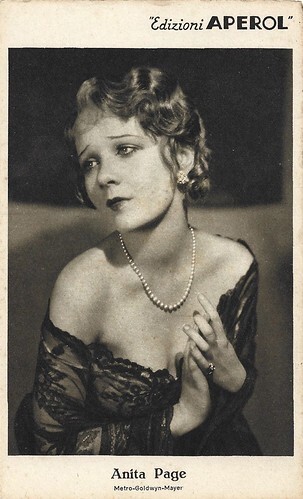
Italian postcard by Edizioni Aperol, Padova. Photo: Metro-Goldwyn-Mayer.
Beautiful Anita Page (1910–2008) was one of the most popular leading ladies of Hollywood during the last years of the silent screen and the first years of the sound era. According to MGM, she received the most fan mail at the time and her nickname was "the girl with the most beautiful face in Hollywood".
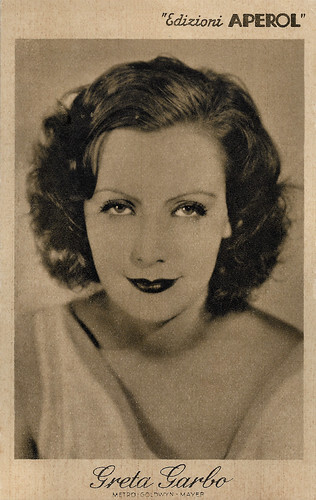
Italian postcard by Edizioni Aperol, Padova. Photo: Metro-Goldwyn-Mayer.
Swedish Greta Garbo (1905-1990) was one of the greatest and most glamorous film stars ever produced by the Hollywood studio system. She was part of the Golden Age of the silent cinema of the 1920s and was one of the few actors who made a glorious transition to the talkies. She started her career in European cinema and would always stay more popular in Europe than in the USA.
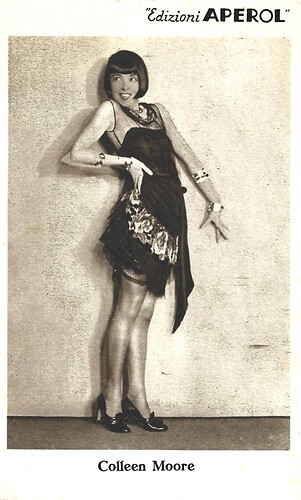
Italian postcard by Edizioni Aperol / Gazzettino di Venezia. Photo: First National. Colleen Moore in Synthetic Sin (William A. Seiter, 1929).
American actress Colleen Moore (1899-1988) was a star of the silent screen who appeared in about 100 films beginning in 1917. During the 1920s, she put her stamp on American social history, creating in dozens of films the image of the wide-eyed, insouciant flapper with her bobbed hair and short skirts.
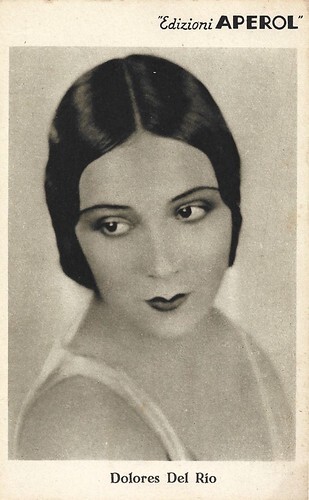
Italian postcard by Edizioni Aperol, Padova.
Mexican and American actress Dolores del Río (1905–1983) was a Hollywood star in the 1920s and 1930s, and one of the most important female actresses of the Golden Age of Mexican cinema in the 1940s and 1950s. Del Río was the first major Latin cross-over star in Hollywood and was considered one of the most beautiful faces that have emerged in Hollywood cinema. She also appeared in several European films.
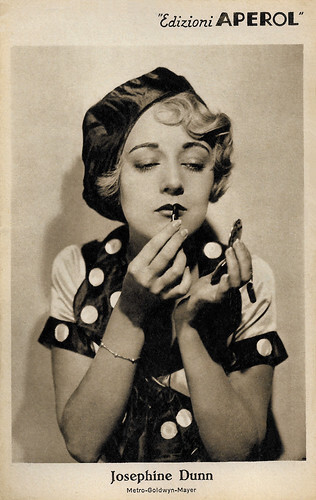
Italian postcard by Edizioni Aperol, Padova. Photo: Ruth Harriet Louise / Metro Goldwyn Mayer.
Josephine Dunn (1906-1983) was an American film actress of the 1920s and 1930s. Dunn got her start as a Broadway chorine when she was only 15 and began working at Paramount five years later, going on to play leading roles through the early 1930s. Later she played supporting leads and was typically cast as the villainess. She left films in 1933.
Women were permitted to drink it
The factory of Aperol and Ovoso was located in Via Niccolò Tomassea in Padova (Padua), as the postcard below shows. The owners were the Barbieri brothers, Luigi and Silvio, who had founded the factory in 1919.
Luigi and Silvio Barbieri created their Aperol aperitivo in 1919 in the liqueur company of their father, after seven years of experimentation. Aperol Barbieria with its distinctive orange-red colour is made from bitter orange, gentian root, rhubarb and a wide range of herbs and roots. The two brothers presented their liquor as a 'therapeutic restorative product'. As the alcohol percentage of Aperol was initially low, women were permitted to drink it.
In the following years, Aperol became popular all over Italy, particularly with young adults gathered in cafes in Padua and traditional bars in Venice. Its bittersweet flavour made the drink very popular as an aperitif. In 1943 the original factory was bombed down, but three years later, the new premises were built in Via Gattamelata, also in Padua.
In the 1950s, the Aperol 'Spritz' was born and the cocktail became very popular in Italy. The recipe is 3 parts of Prosecco D.O.C. (9cl), 2 parts of Aperol (6cl), 1 splash of soda or seltzer (3cl) and 1 slide of orange. This is also the period of the RAI TV advertising programme Carosello with the first Aperol TV commercial, in which actor Tino Buazzelli, bringing his hand to his forehead, pronounced the words 'Ah, Aperol!'.
In 2003 the brand was taken over by Gruppo Campari, but the name still exists. From then on, Spritz spread through Northern Europe as well. Although it smells, tastes and looks like Campari, Aperol has an alcohol content of only 11%, where Campari contains 25% alcohol. Campari is also a bit darker in colour.
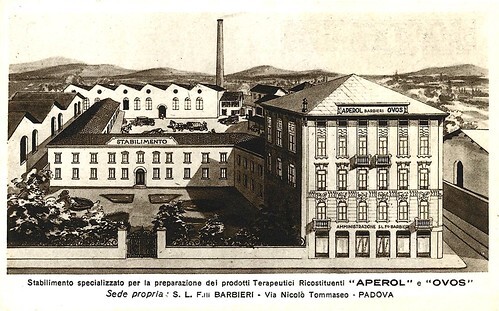
Italian postcard by Edizioni Aperol, ca. 1927-1931. Image: Gazzettino di Venezia.
Factory of Aperol and Ovoso, Via Niccolò Tommaseo, Padova, owned by Fratelli Barbieri. 'A factory specialised in therapeutic restorative products'.
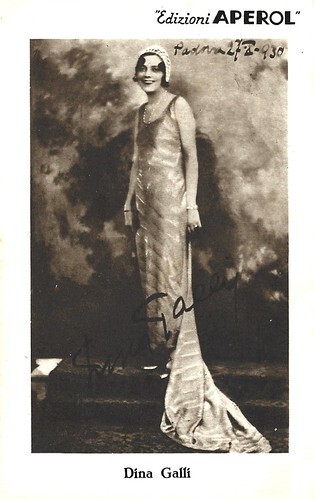
Italian postcard by Edizioni Aperol / Gazzettino di Venezia. Signed and dated, Padova, 27-10-1930.
Dina Galli (1877-1951) was a classic Italian comedienne who also performed in Italian silent and sound cinema.
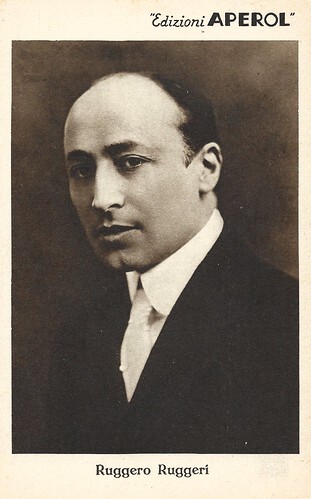
Italian postcard by Edizioni Aperol.
Ruggero Ruggeri (1871-1953) was one the most important Italian stage actors of the first half of the twentieth century. He appeared also in many films.
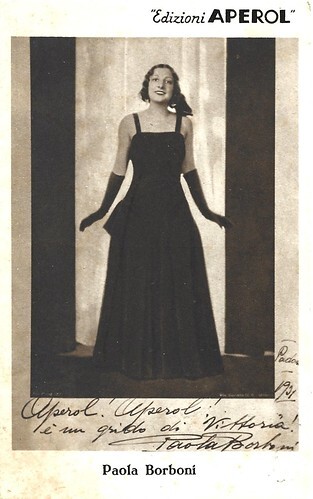
Italian postcard by Edizioni Aperol / Gazzettino di Venezia. Signed by Paola Borboni , Padova 1931. Caption: Aperol! Aperol! è un grido di Vittoria! (Aperol! is a cry of Victory!).
Paola Borboni was one of the greatest stage actresses of Italy (1900-1995). She also played in many films. She was often heard on the radio and seen on television, but her true passion was the stage.
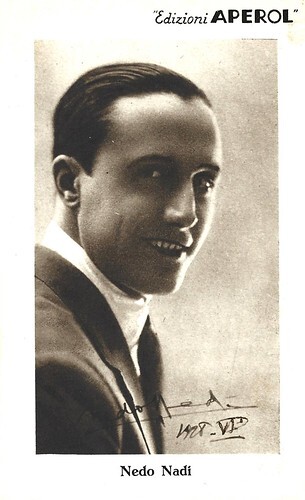
Italian postcard by Edizioni Aperol / Gazzettino di Venezia, 1928.
Nedo Nadi (1894-1940) was one of the most versatile fencers in Olympic history. He was the only one to win titles with all three different weapons at the same Olympic Games in Antwerp in 1920. In Antwerp, he also won the most fencing gold medals ever at a single Games — five.
The revival of the Italian cinema
Following Aperol’s acquisition by Gruppo Campari, the brand started a strong advertising campaign behind Aperol Spritz which built strong ties between consumers and Aperol Spritz through art, music and lifestyle.
In the 1920s, Campari introduced its 'aperitivo' in France with a French postcard campaign with stars of the French silent cinema. The postcard series linked the Italian aperitivo Campari to Paris and to film stars.
Between ca. 1927 and 1931, Aperol tried to do the same with a postcard series of American and Italian stars. The format was 13,8 x 8,8 cm. The series was published by Edizioni Aperol and printed by Gazzettino di Venezia. Aperol is promoted on both sides of the cards.
Some of the postcards of Italian stars such as Paola Borboni and Armando Falconi contain a dedication in which the actors promote Aperol. The only non-actor on the cards is the Olympic fencer Nedo Nadi. Some Italian stars were stage actors, like Ruggero Ruggeri , who had been film stars before the crisis in the Italian film industry in the early 1920s.
The Edizioni Aperol series illustrates how the Italian cinema revived after the introduction of sound film. At the bottom right of the pictures of some of the cards is the logo of the Italian film company Cines-Pittaluga. Stefano Pittaluga (1887-1932) acquired the pioneering film studio Cines from the conglomerate Unione Cinematografica Italiana. Cines-Pittaluga produced the first Italian sound film La canzone dell'amore/The Song of Love (1930), and became the dominant force of the early sound era.
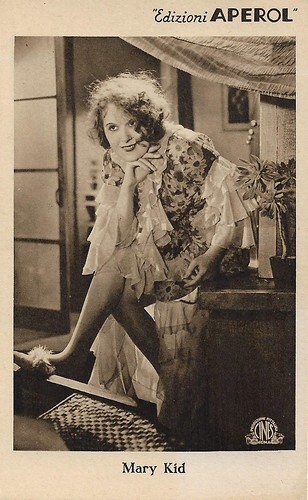
Italian postcard by Edizioni Aperol. Photo: Cines-Pittaluga, Roma.
Mary Kid (1901-1988) was a popular actress of the Austrian and German silent cinema. In 1931 Kid went to Italy where she played in her only two sound films. The first was Rubacuori/Heartbreaker (1931), a comedy by Guido Brignone about an old Casanova (Armando Falconi) who hunts young women until his wife (Tina Lattanzi) finds a jewel that belongs to one of his girlfriends. Falconi’s character comes between a prize fighter (Egon Stief) and his wife ( Mary Kid ). Kid's second Italian film was Kennst Du das Land (1931), the German version of Terra Madre and directed by Constantin J. David. Though produced by the Italian company Cines-Pittaluga and shot by an Italian crew, the cast was German-Austrian.
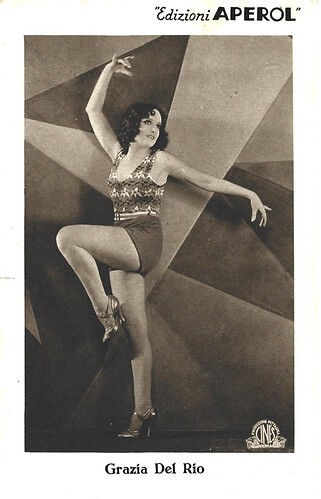
Italian postcard by Edizioni Aperol. Photo: Cines-Pittaluga, Roma.
Little is known about the personal life of Italian actress and singer Grazia Del Rio. Probably because of her singing voice and clear vocals, she had a prolific career in the earliest years of sound cinema. Between 1930 and 1933, she had a short but intense film career in Italy and France, peaking with La stella del cinema (Mario Almirante, 1931) in which she starred. In the late 1930s, she had a second career in Argentina and Chile.
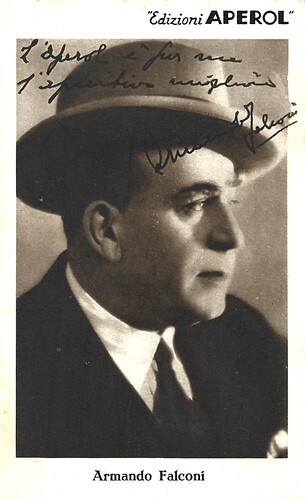
Italian postcard by Edizioni Aperol / Gazzettino di Venezia.
Armando Falconi (1871-1954) was an Italian stage and screen actor. Though he was foremost a theatre actor and comedian, he had a prolific career as a comedian in the 1930s and early 1940s Italian cinema.
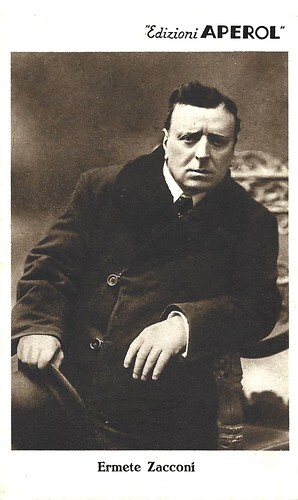
Italian postcard by Edizioni Aperol / Gazzettino di Venezia.
Ermete Zacconi (1857-1948) was a monstre sacré of the Italian theater. He also acted in various Italian silent and sound films.
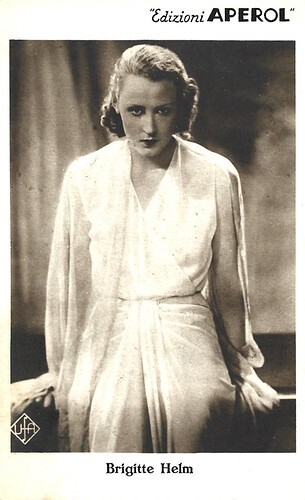
Italian postcard by Edizioni Aperol / Gazzettino di Venezia.
German actress Brigitte Helm (1908-1996) is still famous for her dual role as Maria and her double, the evil Maria, the Maschinenmensch, in the silent SF classic Metropolis (Fritz Lang, 1927). After Metropolis, she made a string of over 30 films in which she almost always had the starring role. She easily made the transition to sound film, before she abruptly retired in 1935.
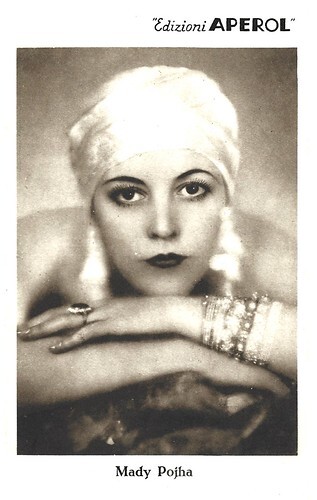
Italian postcard by Edizioni Aperol / Gazzettino di Venezia.
We don't know who Mady Pohja was but Pohja, aka Pooja, is a Finnish last name.
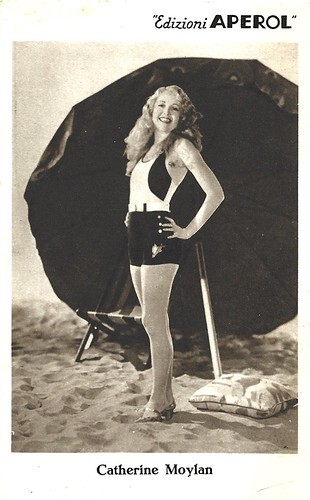
Italian postcard by Edizioni Aperol / Gazzettino di Venezia.
Catherine Moylan (1904-1969) was an American actress of Belgian origin and the first Miss Universe in 1926. After signing with MGM Studios, she began a brief film career in 1930, appearing in two films.
Sources: Aperol and Wikipedia (Italian and Dutch). Check out our posts on the French Campari postcards.

Italian postcard by Edizioni Aperol, Padova. Photo: Metro-Goldwyn-Mayer.
Beautiful Anita Page (1910–2008) was one of the most popular leading ladies of Hollywood during the last years of the silent screen and the first years of the sound era. According to MGM, she received the most fan mail at the time and her nickname was "the girl with the most beautiful face in Hollywood".

Italian postcard by Edizioni Aperol, Padova. Photo: Metro-Goldwyn-Mayer.
Swedish Greta Garbo (1905-1990) was one of the greatest and most glamorous film stars ever produced by the Hollywood studio system. She was part of the Golden Age of the silent cinema of the 1920s and was one of the few actors who made a glorious transition to the talkies. She started her career in European cinema and would always stay more popular in Europe than in the USA.

Italian postcard by Edizioni Aperol / Gazzettino di Venezia. Photo: First National. Colleen Moore in Synthetic Sin (William A. Seiter, 1929).
American actress Colleen Moore (1899-1988) was a star of the silent screen who appeared in about 100 films beginning in 1917. During the 1920s, she put her stamp on American social history, creating in dozens of films the image of the wide-eyed, insouciant flapper with her bobbed hair and short skirts.

Italian postcard by Edizioni Aperol, Padova.
Mexican and American actress Dolores del Río (1905–1983) was a Hollywood star in the 1920s and 1930s, and one of the most important female actresses of the Golden Age of Mexican cinema in the 1940s and 1950s. Del Río was the first major Latin cross-over star in Hollywood and was considered one of the most beautiful faces that have emerged in Hollywood cinema. She also appeared in several European films.

Italian postcard by Edizioni Aperol, Padova. Photo: Ruth Harriet Louise / Metro Goldwyn Mayer.
Josephine Dunn (1906-1983) was an American film actress of the 1920s and 1930s. Dunn got her start as a Broadway chorine when she was only 15 and began working at Paramount five years later, going on to play leading roles through the early 1930s. Later she played supporting leads and was typically cast as the villainess. She left films in 1933.
Women were permitted to drink it
The factory of Aperol and Ovoso was located in Via Niccolò Tomassea in Padova (Padua), as the postcard below shows. The owners were the Barbieri brothers, Luigi and Silvio, who had founded the factory in 1919.
Luigi and Silvio Barbieri created their Aperol aperitivo in 1919 in the liqueur company of their father, after seven years of experimentation. Aperol Barbieria with its distinctive orange-red colour is made from bitter orange, gentian root, rhubarb and a wide range of herbs and roots. The two brothers presented their liquor as a 'therapeutic restorative product'. As the alcohol percentage of Aperol was initially low, women were permitted to drink it.
In the following years, Aperol became popular all over Italy, particularly with young adults gathered in cafes in Padua and traditional bars in Venice. Its bittersweet flavour made the drink very popular as an aperitif. In 1943 the original factory was bombed down, but three years later, the new premises were built in Via Gattamelata, also in Padua.
In the 1950s, the Aperol 'Spritz' was born and the cocktail became very popular in Italy. The recipe is 3 parts of Prosecco D.O.C. (9cl), 2 parts of Aperol (6cl), 1 splash of soda or seltzer (3cl) and 1 slide of orange. This is also the period of the RAI TV advertising programme Carosello with the first Aperol TV commercial, in which actor Tino Buazzelli, bringing his hand to his forehead, pronounced the words 'Ah, Aperol!'.
In 2003 the brand was taken over by Gruppo Campari, but the name still exists. From then on, Spritz spread through Northern Europe as well. Although it smells, tastes and looks like Campari, Aperol has an alcohol content of only 11%, where Campari contains 25% alcohol. Campari is also a bit darker in colour.

Italian postcard by Edizioni Aperol, ca. 1927-1931. Image: Gazzettino di Venezia.
Factory of Aperol and Ovoso, Via Niccolò Tommaseo, Padova, owned by Fratelli Barbieri. 'A factory specialised in therapeutic restorative products'.

Italian postcard by Edizioni Aperol / Gazzettino di Venezia. Signed and dated, Padova, 27-10-1930.
Dina Galli (1877-1951) was a classic Italian comedienne who also performed in Italian silent and sound cinema.

Italian postcard by Edizioni Aperol.
Ruggero Ruggeri (1871-1953) was one the most important Italian stage actors of the first half of the twentieth century. He appeared also in many films.

Italian postcard by Edizioni Aperol / Gazzettino di Venezia. Signed by Paola Borboni , Padova 1931. Caption: Aperol! Aperol! è un grido di Vittoria! (Aperol! is a cry of Victory!).
Paola Borboni was one of the greatest stage actresses of Italy (1900-1995). She also played in many films. She was often heard on the radio and seen on television, but her true passion was the stage.

Italian postcard by Edizioni Aperol / Gazzettino di Venezia, 1928.
Nedo Nadi (1894-1940) was one of the most versatile fencers in Olympic history. He was the only one to win titles with all three different weapons at the same Olympic Games in Antwerp in 1920. In Antwerp, he also won the most fencing gold medals ever at a single Games — five.
The revival of the Italian cinema
Following Aperol’s acquisition by Gruppo Campari, the brand started a strong advertising campaign behind Aperol Spritz which built strong ties between consumers and Aperol Spritz through art, music and lifestyle.
In the 1920s, Campari introduced its 'aperitivo' in France with a French postcard campaign with stars of the French silent cinema. The postcard series linked the Italian aperitivo Campari to Paris and to film stars.
Between ca. 1927 and 1931, Aperol tried to do the same with a postcard series of American and Italian stars. The format was 13,8 x 8,8 cm. The series was published by Edizioni Aperol and printed by Gazzettino di Venezia. Aperol is promoted on both sides of the cards.
Some of the postcards of Italian stars such as Paola Borboni and Armando Falconi contain a dedication in which the actors promote Aperol. The only non-actor on the cards is the Olympic fencer Nedo Nadi. Some Italian stars were stage actors, like Ruggero Ruggeri , who had been film stars before the crisis in the Italian film industry in the early 1920s.
The Edizioni Aperol series illustrates how the Italian cinema revived after the introduction of sound film. At the bottom right of the pictures of some of the cards is the logo of the Italian film company Cines-Pittaluga. Stefano Pittaluga (1887-1932) acquired the pioneering film studio Cines from the conglomerate Unione Cinematografica Italiana. Cines-Pittaluga produced the first Italian sound film La canzone dell'amore/The Song of Love (1930), and became the dominant force of the early sound era.

Italian postcard by Edizioni Aperol. Photo: Cines-Pittaluga, Roma.
Mary Kid (1901-1988) was a popular actress of the Austrian and German silent cinema. In 1931 Kid went to Italy where she played in her only two sound films. The first was Rubacuori/Heartbreaker (1931), a comedy by Guido Brignone about an old Casanova (Armando Falconi) who hunts young women until his wife (Tina Lattanzi) finds a jewel that belongs to one of his girlfriends. Falconi’s character comes between a prize fighter (Egon Stief) and his wife ( Mary Kid ). Kid's second Italian film was Kennst Du das Land (1931), the German version of Terra Madre and directed by Constantin J. David. Though produced by the Italian company Cines-Pittaluga and shot by an Italian crew, the cast was German-Austrian.

Italian postcard by Edizioni Aperol. Photo: Cines-Pittaluga, Roma.
Little is known about the personal life of Italian actress and singer Grazia Del Rio. Probably because of her singing voice and clear vocals, she had a prolific career in the earliest years of sound cinema. Between 1930 and 1933, she had a short but intense film career in Italy and France, peaking with La stella del cinema (Mario Almirante, 1931) in which she starred. In the late 1930s, she had a second career in Argentina and Chile.

Italian postcard by Edizioni Aperol / Gazzettino di Venezia.
Armando Falconi (1871-1954) was an Italian stage and screen actor. Though he was foremost a theatre actor and comedian, he had a prolific career as a comedian in the 1930s and early 1940s Italian cinema.

Italian postcard by Edizioni Aperol / Gazzettino di Venezia.
Ermete Zacconi (1857-1948) was a monstre sacré of the Italian theater. He also acted in various Italian silent and sound films.

Italian postcard by Edizioni Aperol / Gazzettino di Venezia.
German actress Brigitte Helm (1908-1996) is still famous for her dual role as Maria and her double, the evil Maria, the Maschinenmensch, in the silent SF classic Metropolis (Fritz Lang, 1927). After Metropolis, she made a string of over 30 films in which she almost always had the starring role. She easily made the transition to sound film, before she abruptly retired in 1935.

Italian postcard by Edizioni Aperol / Gazzettino di Venezia.
We don't know who Mady Pohja was but Pohja, aka Pooja, is a Finnish last name.

Italian postcard by Edizioni Aperol / Gazzettino di Venezia.
Catherine Moylan (1904-1969) was an American actress of Belgian origin and the first Miss Universe in 1926. After signing with MGM Studios, she began a brief film career in 1930, appearing in two films.
Sources: Aperol and Wikipedia (Italian and Dutch). Check out our posts on the French Campari postcards.
Published on February 04, 2024 22:00
February 3, 2024
Bonita Granville
American actress Bonita Granville (1923-1988) made her film debut at the age of 9, in Westward Passage (1932). She was regularly cast as a naughty little girl and was nominated for a Best Supporting Actress award for These Three (1936). In 1938-1939 she played the bright and feisty detective/reporter Nancy Drew in the Nancy Drew series. She also appeared with Mickey Rooney in a few Andy Hardy films. Later, she worked as a producer of the Lassie (1954) TV series.
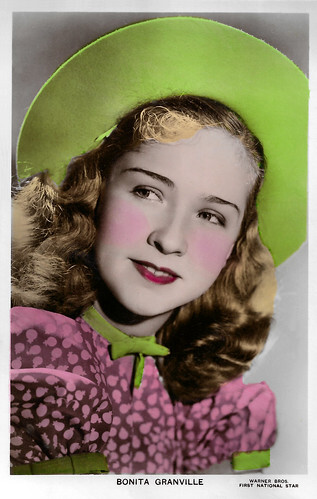
British postcard in the Colourgraph Series, London, no. C 320. Photo: Warner Bros / First National.
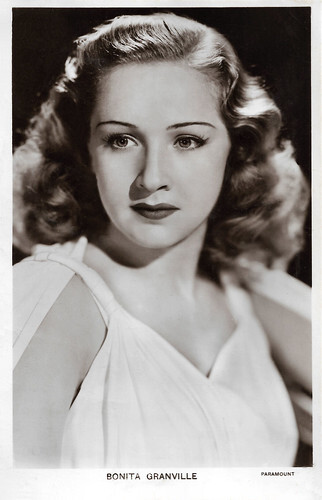
British postcard in the Picturegoer Series, London, no. 1120b. Photo: Paramount.
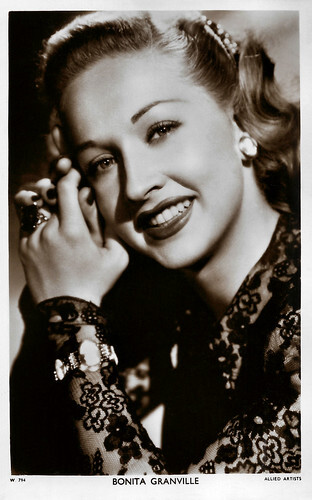
British postcard in the Picturegoer Series, London, no. W. 794. Photo: Allied Artists.
Teenage amateur sleuth Nancy Drew
Bonita Granville was born in Manhattan, New York, in 1923. She was the daughter of Rosina (née Timponi) and Bernard Granville. Both her parents were stage performers and Bonita's theatre career began as a child. Before her tenth birthday, she made her film debut in Westward Passage (Robert Milton, 1932), starring Ann Harding and Laurence Olivier .
In the following years, she got mostly extra roles, such as in Cavalcade (Frank Lloyd, 1933) with Diana Wynyard , the famous Little Women (George Cukor, 1933) starring Katharine Hepburn , and The Garden of Allah (Richard Boleslawski, 1936) with Marlene Dietrich .
Bonita Granville proved herself in a bigger role in These Three (William Wyler, 1936), the film adaptation of Lillian Hellman's 1934 stage play 'The Children's Hour'. The film tells the story of three adults (played by Miriam Hopkins , Merle Oberon , and Joel McCrea) who find their lives almost destroyed when an attention-seeking schoolgirl accuses her two schoolmistresses of lesbianism. For her role as that child, Granville was nominated for an Academy Award for Best Supporting Actress, then the youngest person to be nominated for an Oscar.
In 1937, Warner Bros. bought the rights to the book series about teenage amateur sleuth Nancy Drew. From 1938 to 1939, Bonita Granville played the girl detective in a series of four B films. All of them were directed by William Clemens and had the same primary cast with Granville as Nancy Drew, John Litel as her father Carson Drew, and Frankie Thomas as Ted Nickerson. The first two films did well enough to allow Warner Bros. to expand the budgets for the third and fourth films.
Granville also appeared as the saucy, mischievous daughter in the multiple Academy Award-nominated hit comedy Merrily We Live (Norman Z. McLeod, 1938), and starred as the title character in The Beloved Brat (Arthur Lubin, 1938). She also had Angels Wash Their Faces (Ray Enright, 1939) alongside Ann Sheridan and Ronald Reagan .
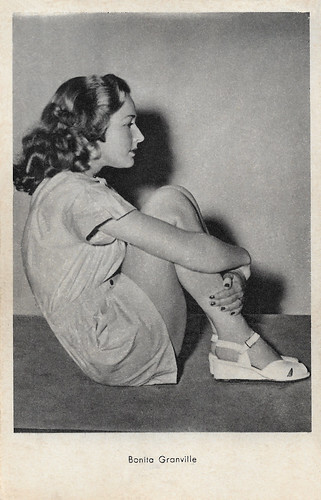
Vintage postcard.
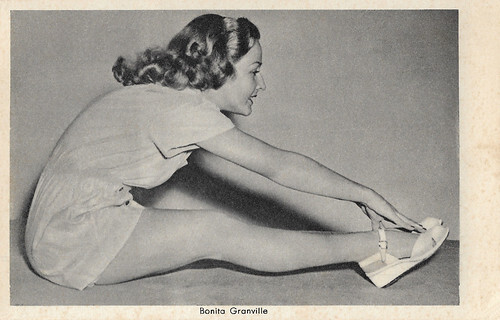
Vintage postcard.
Andy Hardy's Blonde Trouble
In 1941, Bonita Granville signed with RKO Pictures and immediately found more substantial supporting roles in the crime drama The Glass Key (Frank Tuttle, 1942) and the drama Now, Voyager (Irving Rapper, 1942) starring Bette Davis , for which she was loaned out to Paramount and Warner Bros.Following her leading role in the action film Seven Miles from Alcatraz (1942), director Edward Dmytryk, soon cast her in RKO's World War II anti-Nazism film Hitler's Children (1943). It is known for its portrayal of brutality associated with the Hitler Youth, represented particularly by two young participants. The film was a commercial and critical success, becoming one of the studio's highest-grossing films of the year, and one of the highest-grossing for both RKO and 1943.
Despite her success, she was still offered few roles and had to work hard for them. The studio relegated her to B-films such as Youth Runs Wild (Mark Robson, 1944) and The Truth About Murder (Lew Landers, 1946). She continued to be loaned out to other studios. She was loaned to MGM for two Andy Hardy films with Mickey Rooney , Andy Hardy's Blonde Trouble (George B. Seitz, 1944) and Love Laughs at Andy Hardy (Willis Goldbeck, 1946), as well as a leading role in Song of the Open Road (S. Sylvan Simon, 1944) with Jane Powell .
At Universal, she played in the comedy The Beautiful Cheat (Charles Barton, 1945) and the comedy-drama Senorita from the West (Frank Strayer, 1945) with Allan Jones. For United Artists, she made the comedy Breakfast in Hollywood (Harold D. Schuster, 1946). Following being loaned out to Monogram Pictures for the ice-skating-themed Film Noir Suspense (Frank Tuttle, 1946) starring Barry Sullivan and former Olympic skater Belita, and the Film Noir The Guilty (John Reinhardt, 1947), Granville informally retired from films, only appearing in the comedy Strike It Rich (Lesley Selander, 1948) and the anti-communist drama Guilty of Treason (Felix E. Feist, 1950) starring Charles Bickford .
After marrying Texas oil millionaire Jack Wrather in 1947, Granville transitioned into producing with her husband on series such as Lassie (1954). She appeared in the film version of The Lone Ranger (Stuart Heisler, 1956) based on The Lone Ranger television series starring Clayton Moore and Jay Silverheels, and made her final screen appearance in a cameo role in The Legend of the Lone Ranger (William A. Fraker, 1981).
Retired from acting, she worked as a philanthropist and a businesswoman, most notably owning and operating the Disneyland Hotel and the Queen Mary in Long Beach, with her husband. Granville's marriage to Wrather lasted until Wrather died in 1984, shortly after the release of the film The Magic of Lassie (Don Chaffey, 1978), co-produced by Granville and starring Wrather's friend James Stewart . Bonita Granville died of lung cancer in a hospital in Santa Monica in 1988 at the age of 65. She was buried at the Holy Cross Cemetery in Culver City, California.
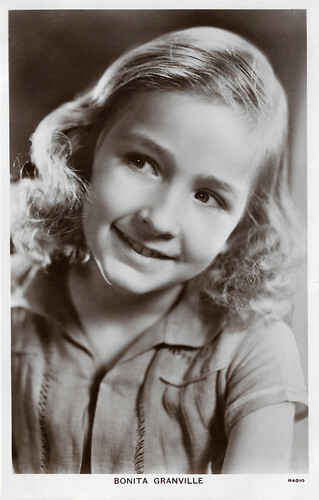
British postcard in the Picturegoer Series, London, no. 1120. Photo: Radio.
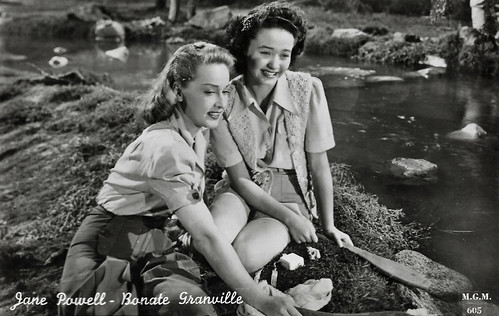
Dutch postcard, no. 605. Photo: M.G.M. Jane Powell and Bonita Granville in Song of the Open Road (S. Sylvan Simon, 1944). Sent by mail in 1954.
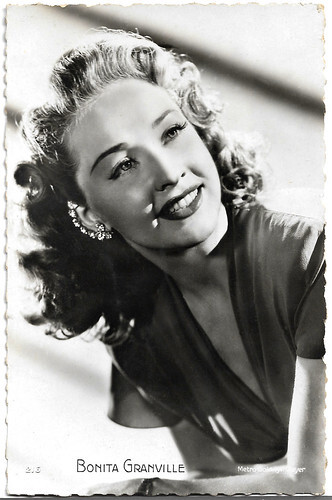
French postcard by Editions P.I., Paris, no. 216. Photo: Metro-Goldwyn-Mayer.
Sources: Burt A. Folkart (Los Angeles Times), Wikipedia (Dutch and English) and .

British postcard in the Colourgraph Series, London, no. C 320. Photo: Warner Bros / First National.

British postcard in the Picturegoer Series, London, no. 1120b. Photo: Paramount.

British postcard in the Picturegoer Series, London, no. W. 794. Photo: Allied Artists.
Teenage amateur sleuth Nancy Drew
Bonita Granville was born in Manhattan, New York, in 1923. She was the daughter of Rosina (née Timponi) and Bernard Granville. Both her parents were stage performers and Bonita's theatre career began as a child. Before her tenth birthday, she made her film debut in Westward Passage (Robert Milton, 1932), starring Ann Harding and Laurence Olivier .
In the following years, she got mostly extra roles, such as in Cavalcade (Frank Lloyd, 1933) with Diana Wynyard , the famous Little Women (George Cukor, 1933) starring Katharine Hepburn , and The Garden of Allah (Richard Boleslawski, 1936) with Marlene Dietrich .
Bonita Granville proved herself in a bigger role in These Three (William Wyler, 1936), the film adaptation of Lillian Hellman's 1934 stage play 'The Children's Hour'. The film tells the story of three adults (played by Miriam Hopkins , Merle Oberon , and Joel McCrea) who find their lives almost destroyed when an attention-seeking schoolgirl accuses her two schoolmistresses of lesbianism. For her role as that child, Granville was nominated for an Academy Award for Best Supporting Actress, then the youngest person to be nominated for an Oscar.
In 1937, Warner Bros. bought the rights to the book series about teenage amateur sleuth Nancy Drew. From 1938 to 1939, Bonita Granville played the girl detective in a series of four B films. All of them were directed by William Clemens and had the same primary cast with Granville as Nancy Drew, John Litel as her father Carson Drew, and Frankie Thomas as Ted Nickerson. The first two films did well enough to allow Warner Bros. to expand the budgets for the third and fourth films.
Granville also appeared as the saucy, mischievous daughter in the multiple Academy Award-nominated hit comedy Merrily We Live (Norman Z. McLeod, 1938), and starred as the title character in The Beloved Brat (Arthur Lubin, 1938). She also had Angels Wash Their Faces (Ray Enright, 1939) alongside Ann Sheridan and Ronald Reagan .

Vintage postcard.

Vintage postcard.
Andy Hardy's Blonde Trouble
In 1941, Bonita Granville signed with RKO Pictures and immediately found more substantial supporting roles in the crime drama The Glass Key (Frank Tuttle, 1942) and the drama Now, Voyager (Irving Rapper, 1942) starring Bette Davis , for which she was loaned out to Paramount and Warner Bros.Following her leading role in the action film Seven Miles from Alcatraz (1942), director Edward Dmytryk, soon cast her in RKO's World War II anti-Nazism film Hitler's Children (1943). It is known for its portrayal of brutality associated with the Hitler Youth, represented particularly by two young participants. The film was a commercial and critical success, becoming one of the studio's highest-grossing films of the year, and one of the highest-grossing for both RKO and 1943.
Despite her success, she was still offered few roles and had to work hard for them. The studio relegated her to B-films such as Youth Runs Wild (Mark Robson, 1944) and The Truth About Murder (Lew Landers, 1946). She continued to be loaned out to other studios. She was loaned to MGM for two Andy Hardy films with Mickey Rooney , Andy Hardy's Blonde Trouble (George B. Seitz, 1944) and Love Laughs at Andy Hardy (Willis Goldbeck, 1946), as well as a leading role in Song of the Open Road (S. Sylvan Simon, 1944) with Jane Powell .
At Universal, she played in the comedy The Beautiful Cheat (Charles Barton, 1945) and the comedy-drama Senorita from the West (Frank Strayer, 1945) with Allan Jones. For United Artists, she made the comedy Breakfast in Hollywood (Harold D. Schuster, 1946). Following being loaned out to Monogram Pictures for the ice-skating-themed Film Noir Suspense (Frank Tuttle, 1946) starring Barry Sullivan and former Olympic skater Belita, and the Film Noir The Guilty (John Reinhardt, 1947), Granville informally retired from films, only appearing in the comedy Strike It Rich (Lesley Selander, 1948) and the anti-communist drama Guilty of Treason (Felix E. Feist, 1950) starring Charles Bickford .
After marrying Texas oil millionaire Jack Wrather in 1947, Granville transitioned into producing with her husband on series such as Lassie (1954). She appeared in the film version of The Lone Ranger (Stuart Heisler, 1956) based on The Lone Ranger television series starring Clayton Moore and Jay Silverheels, and made her final screen appearance in a cameo role in The Legend of the Lone Ranger (William A. Fraker, 1981).
Retired from acting, she worked as a philanthropist and a businesswoman, most notably owning and operating the Disneyland Hotel and the Queen Mary in Long Beach, with her husband. Granville's marriage to Wrather lasted until Wrather died in 1984, shortly after the release of the film The Magic of Lassie (Don Chaffey, 1978), co-produced by Granville and starring Wrather's friend James Stewart . Bonita Granville died of lung cancer in a hospital in Santa Monica in 1988 at the age of 65. She was buried at the Holy Cross Cemetery in Culver City, California.

British postcard in the Picturegoer Series, London, no. 1120. Photo: Radio.

Dutch postcard, no. 605. Photo: M.G.M. Jane Powell and Bonita Granville in Song of the Open Road (S. Sylvan Simon, 1944). Sent by mail in 1954.

French postcard by Editions P.I., Paris, no. 216. Photo: Metro-Goldwyn-Mayer.
Sources: Burt A. Folkart (Los Angeles Times), Wikipedia (Dutch and English) and .
Published on February 03, 2024 22:00
February 2, 2024
Donald O'Connor
Donald O'Connor (1925-2003) was an American dancer and actor in several Universal musicals of the 1940s. His best-known musical is Singin' in the Rain (1952), in which he did an impressive dance that culminated in a series of backflips off the wall. O'Connor was also effective in comedies, particularly as the companion to Francis the Talking Mule in that film series.
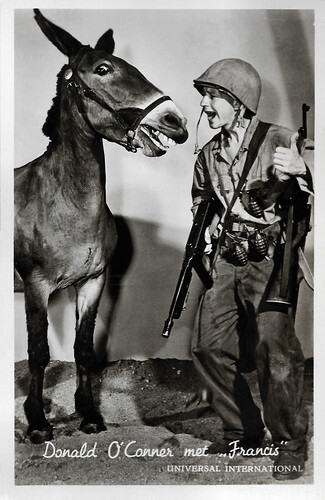
Belgian postcard by Nieuwe Merksemsche Chocolaterie S.P.R.L, Merksem (Anvers), no. B 16. Photo: Universal International. Donald O'Connor and Francis the Talking Mule in Francis in the Navy (Arthur Lubin, 1955).
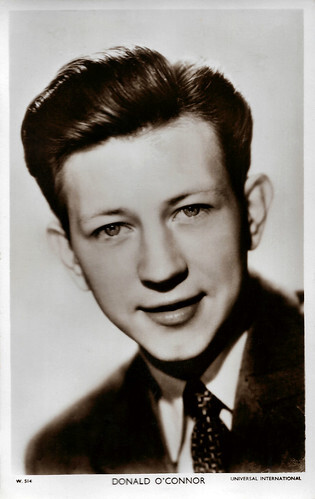
British postcard in the Picturegoer Series, London, no. W 514. Photo: Universal International.
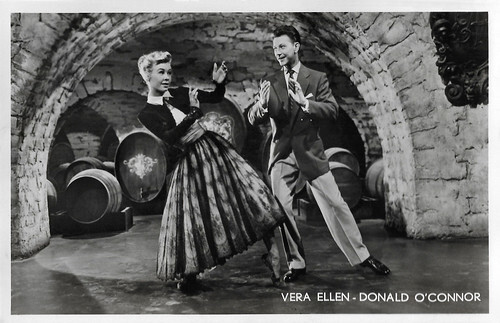
Dutch postcard by J. Sleding N.V., Amsterdam, no. 46. Photo: 20th Century Fox. Vera-Ellen and Donald O'Connor in Call Me Madam (Walter Lang, 1953).
A long series of peppy, low-budget musicals
Donald O'Connor was born in Chicago, Illinois, in 1925. He was the son of Irene and John Edward "Chuck" O'Connor, Irish immigrants who performed in vaudeville shows, the English counterpart of revue. O’Connor made his first stage appearance at the age of 13 months. He spent his childhood touring with his family’s vaudeville act and was reportedly able to dance before he could stand up straight, to sing before he developed a vocabulary, and to play several musical instruments before he learned to read music.
As a child, Donald was involved in a car accident outside a theatre in Hartford in which his sister was killed. His father died of a heart attack a few weeks later. From then on, the half-orphan appeared on the theatre stage. When he was 12, he and his two brothers were hired for a specialty act in the film musical Melody for Two (Louis King, 1937).
The following year he was signed to a $250-per-week contract at Paramount Pictures. His first film was Sing, You Sinners (Wesley Ruggles, 1938), in which he played Bing Crosby ’s younger brother. During his one-year stay at Paramount, he occasionally portrayed the leading man as a youth in such films as Men with Wings (William A. Wellman, 1938) and the adventure film Beau Geste (William A. Wellman, 1939) with Gary Cooper , Robert Preston and Ray Milland in the leading roles.
He was also cast as Huck Finn in Tom Sawyer, Detective (Louis King, 1938). In addition to his film appearances, the child actor received training in singing and dancing. Donald became known as a comic actor and singer/dancer. After O'Connor had outgrown his child roles, he signed a studio contract with Universal Pictures in 1941.
He played leading roles in a long series of peppy, low-budget musicals, aimed primarily at young audiences. Among his most frequent partners at Universal were singer-dancer Peggy Ryan and actress Gloria Jean, alongside whom he appeared in four films each. From 1944, O'Connor served in the U.S. Special Services Corps, giving innumerable performances for his fellow servicemen. Universal withheld some of his films from cinemas for so long that even during his two-year absence from Hollywood, new films of his were regularly released.
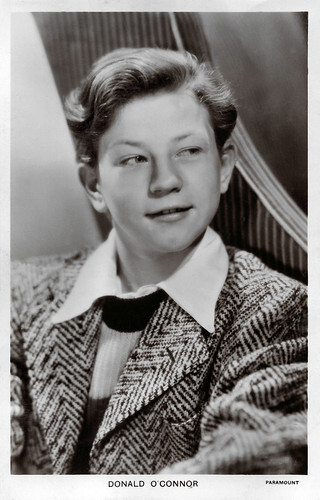
British postcard in the Picturegoer Series, London, no. 1381. Photo: Paramount.
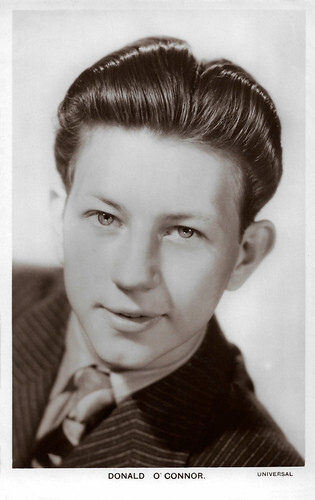
British postcard in the Picturegoer Series, London, no. W 125. Photo: Universal.
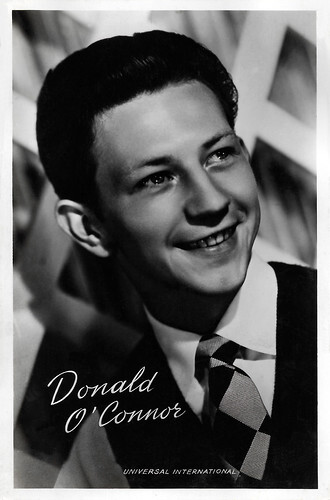
Dutch postcard by Takken / 't Sticht, no. 947. Photo: Universal International.
A talking mule named Francis
Donald O'Connor reached the peak of his career in the 1940s and 1950s at Universal Pictures. His first film after the war was Something in the Wind (Irving Pichel, 1947), in which he played the male lead alongside Deanna Durbin . Further musical films at Universal such as Yes Sir, That's My Baby (George Sherman, 1949) followed. In 1950, O'Connor played the comedic lead in the film Francis (Arthur Lubin, 1950), about a soldier named Peter Stirling who befriends a talking donkey named Francis. Francis was so successful that five more films for O'Connor and Francis the donkey followed until 1955. O'Connor later expressed some frustration that the donkey had received more fan letters than he had.
His most famous role was as Cosmo alongside Gene Kelly and Debbie Reynolds in the classic musical Singin' In The Rain (Stanley Donen, 1952). O'Connor also sang the well-known song 'Make 'Em Laugh', in which he was also able to show off his talent for dynamic dance interludes. His performance in Singin' in the Rain was honoured with a Golden Globe Award. Less famous but no less impressive was his tap dance on roller skates in I Love Melvin (Don Weis, 1953).
Because of his boyish looks, romantic leads never fell to him, except when he was alongside bigger stars like Ethel Merman in Call Me Madam (Walter Lang, 1953) and Marilyn Monroe in There’s No Business Like Show Business (Walter Lang, 1954). Between 1954 and 1955, the television station NBC produced the musical sitcom The Donald O'Connor Show with him in the leading role. The heyday of the film musical came to an end, the increasing age of O'Connor, who subscribed to boyish roles and his alcohol problems caused O'Connor's career to falter in the second half of the 1950s.
After leaving Universal, he played silent film star Buster Keaton in the rather inaccurate biopic The Buster Keaton Story (Sidney Sheldon, 1957), but was unable to make a lasting impression. After that, leading roles in Hollywood became rare for him. In 1961, he played the title role in the Italian adventure film Le Meraviglie di Aladino/Aladdin's Adventures (Mario Bava, Henry Levin, 1961) with Noëlle Adam and Mario Girotti (a.k.a. Terence Hill ). O'Connor had a short-lived television series in the 1960s.
After overcoming his drinking problem in the 1970s, he returned to the stage and appeared in the Broadway musicals 'Bring Back Birdie' (1981) and as Cap’n Andy in a revival of 'Show Boat' (1982). He continued film and television appearances into the 1990s. He played character parts in Ragtime (Milos Forman, 1981) starring James Cagney and the comedy Toys (Barry Levinson, 1992) with Robin Williams . O'Connor's last film was the Walter Matthau- Jack Lemmon comedy Out to Sea (Martha Coolidge, 1997). In 2003, Donald O'Connor passed away in Calabasas, California He left behind a wife, Gloria, and four children.
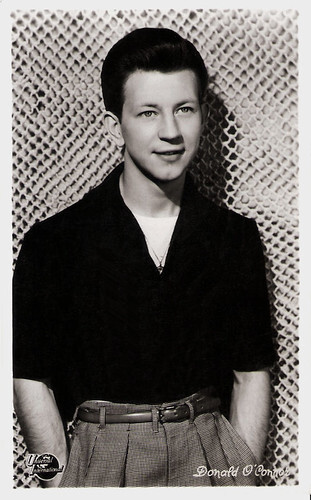
Belgian collectors card by Fotoprim, Brussels, for De Beukelaer, Antwerpen, no. A 46. Photo: Universal International.
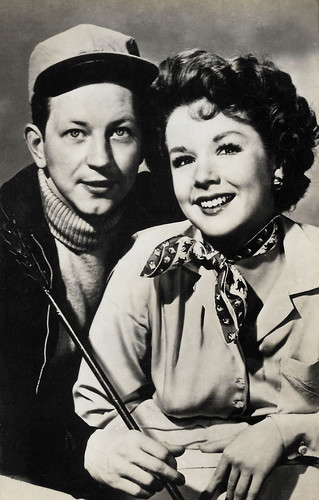
Spanish postcard. Photo: Universal International. Piper Laurie and Donald O'Connor in Francis Goes to the Races (Arthur Lubin, 1951).
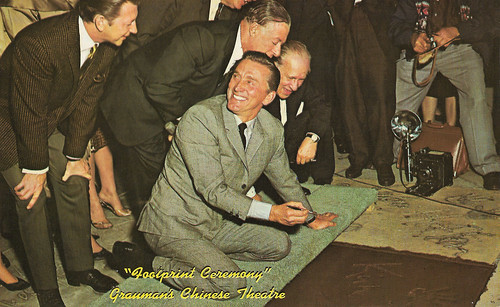
American postcard by Colourpicture, Boston, Mass., no. P51738. Caption: Grauman's Chinese Theatre, Hollywood, California. In the wet cement of the world-famous forecourt, Mr. Kirk Douglas becomes a movie immortal as a crowd including Donald O'Connor and George Jessel looks on.
Sources: Britannica, Wikipedia (Dutch and German) and .

Belgian postcard by Nieuwe Merksemsche Chocolaterie S.P.R.L, Merksem (Anvers), no. B 16. Photo: Universal International. Donald O'Connor and Francis the Talking Mule in Francis in the Navy (Arthur Lubin, 1955).

British postcard in the Picturegoer Series, London, no. W 514. Photo: Universal International.

Dutch postcard by J. Sleding N.V., Amsterdam, no. 46. Photo: 20th Century Fox. Vera-Ellen and Donald O'Connor in Call Me Madam (Walter Lang, 1953).
A long series of peppy, low-budget musicals
Donald O'Connor was born in Chicago, Illinois, in 1925. He was the son of Irene and John Edward "Chuck" O'Connor, Irish immigrants who performed in vaudeville shows, the English counterpart of revue. O’Connor made his first stage appearance at the age of 13 months. He spent his childhood touring with his family’s vaudeville act and was reportedly able to dance before he could stand up straight, to sing before he developed a vocabulary, and to play several musical instruments before he learned to read music.
As a child, Donald was involved in a car accident outside a theatre in Hartford in which his sister was killed. His father died of a heart attack a few weeks later. From then on, the half-orphan appeared on the theatre stage. When he was 12, he and his two brothers were hired for a specialty act in the film musical Melody for Two (Louis King, 1937).
The following year he was signed to a $250-per-week contract at Paramount Pictures. His first film was Sing, You Sinners (Wesley Ruggles, 1938), in which he played Bing Crosby ’s younger brother. During his one-year stay at Paramount, he occasionally portrayed the leading man as a youth in such films as Men with Wings (William A. Wellman, 1938) and the adventure film Beau Geste (William A. Wellman, 1939) with Gary Cooper , Robert Preston and Ray Milland in the leading roles.
He was also cast as Huck Finn in Tom Sawyer, Detective (Louis King, 1938). In addition to his film appearances, the child actor received training in singing and dancing. Donald became known as a comic actor and singer/dancer. After O'Connor had outgrown his child roles, he signed a studio contract with Universal Pictures in 1941.
He played leading roles in a long series of peppy, low-budget musicals, aimed primarily at young audiences. Among his most frequent partners at Universal were singer-dancer Peggy Ryan and actress Gloria Jean, alongside whom he appeared in four films each. From 1944, O'Connor served in the U.S. Special Services Corps, giving innumerable performances for his fellow servicemen. Universal withheld some of his films from cinemas for so long that even during his two-year absence from Hollywood, new films of his were regularly released.

British postcard in the Picturegoer Series, London, no. 1381. Photo: Paramount.

British postcard in the Picturegoer Series, London, no. W 125. Photo: Universal.

Dutch postcard by Takken / 't Sticht, no. 947. Photo: Universal International.
A talking mule named Francis
Donald O'Connor reached the peak of his career in the 1940s and 1950s at Universal Pictures. His first film after the war was Something in the Wind (Irving Pichel, 1947), in which he played the male lead alongside Deanna Durbin . Further musical films at Universal such as Yes Sir, That's My Baby (George Sherman, 1949) followed. In 1950, O'Connor played the comedic lead in the film Francis (Arthur Lubin, 1950), about a soldier named Peter Stirling who befriends a talking donkey named Francis. Francis was so successful that five more films for O'Connor and Francis the donkey followed until 1955. O'Connor later expressed some frustration that the donkey had received more fan letters than he had.
His most famous role was as Cosmo alongside Gene Kelly and Debbie Reynolds in the classic musical Singin' In The Rain (Stanley Donen, 1952). O'Connor also sang the well-known song 'Make 'Em Laugh', in which he was also able to show off his talent for dynamic dance interludes. His performance in Singin' in the Rain was honoured with a Golden Globe Award. Less famous but no less impressive was his tap dance on roller skates in I Love Melvin (Don Weis, 1953).
Because of his boyish looks, romantic leads never fell to him, except when he was alongside bigger stars like Ethel Merman in Call Me Madam (Walter Lang, 1953) and Marilyn Monroe in There’s No Business Like Show Business (Walter Lang, 1954). Between 1954 and 1955, the television station NBC produced the musical sitcom The Donald O'Connor Show with him in the leading role. The heyday of the film musical came to an end, the increasing age of O'Connor, who subscribed to boyish roles and his alcohol problems caused O'Connor's career to falter in the second half of the 1950s.
After leaving Universal, he played silent film star Buster Keaton in the rather inaccurate biopic The Buster Keaton Story (Sidney Sheldon, 1957), but was unable to make a lasting impression. After that, leading roles in Hollywood became rare for him. In 1961, he played the title role in the Italian adventure film Le Meraviglie di Aladino/Aladdin's Adventures (Mario Bava, Henry Levin, 1961) with Noëlle Adam and Mario Girotti (a.k.a. Terence Hill ). O'Connor had a short-lived television series in the 1960s.
After overcoming his drinking problem in the 1970s, he returned to the stage and appeared in the Broadway musicals 'Bring Back Birdie' (1981) and as Cap’n Andy in a revival of 'Show Boat' (1982). He continued film and television appearances into the 1990s. He played character parts in Ragtime (Milos Forman, 1981) starring James Cagney and the comedy Toys (Barry Levinson, 1992) with Robin Williams . O'Connor's last film was the Walter Matthau- Jack Lemmon comedy Out to Sea (Martha Coolidge, 1997). In 2003, Donald O'Connor passed away in Calabasas, California He left behind a wife, Gloria, and four children.

Belgian collectors card by Fotoprim, Brussels, for De Beukelaer, Antwerpen, no. A 46. Photo: Universal International.

Spanish postcard. Photo: Universal International. Piper Laurie and Donald O'Connor in Francis Goes to the Races (Arthur Lubin, 1951).

American postcard by Colourpicture, Boston, Mass., no. P51738. Caption: Grauman's Chinese Theatre, Hollywood, California. In the wet cement of the world-famous forecourt, Mr. Kirk Douglas becomes a movie immortal as a crowd including Donald O'Connor and George Jessel looks on.
Sources: Britannica, Wikipedia (Dutch and German) and .
Published on February 02, 2024 22:00
February 1, 2024
Malcolm McDowell
English actor Malcolm McDowell (1943) played a large number of lead and supporting roles in films and television productions but is best known for his leading role in Stanley Kubrick's classic A Clockwork Orange (1971). The image of the villainous Alex DeLarge from A Clockwork Orange ensured that McDowell was regularly cast as the villain.
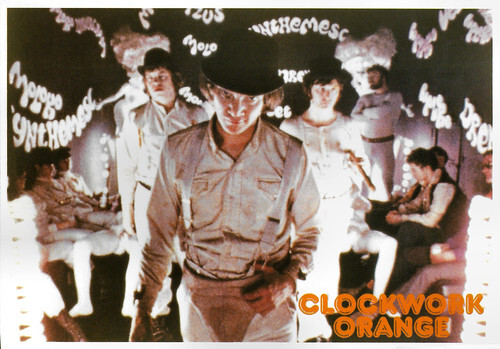
Vintage postcard by Memory Card, no. 475. Malcolm McDowell, Warren Clarke, Paul Farrell, Michael Tarn and James Marcus in A Clockwork Orange (Stanley Kubrick, 1971).
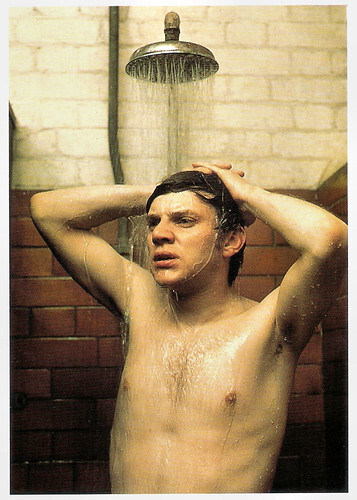
British postcard by Paramount Pictures for the DVD release (2007), no. GI101327PK. Photo: Paramount Pictures. Malcolm McDowell in If... (Lindsay Anderson, 1968).
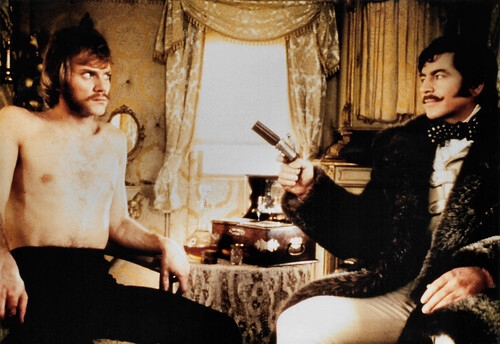
Vintage photo. Malcolm McDowell and Alan Bates in Royal Flash (Richard Lester, 1975).
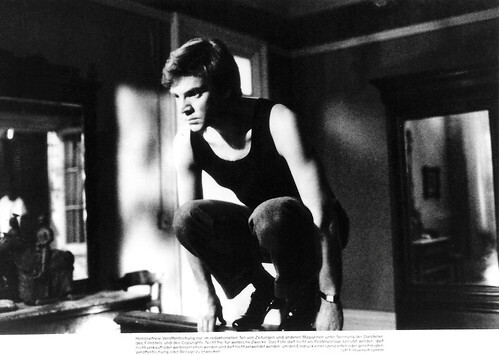
German press photo by UIP Filmverleih, no. P3. Malcolm McDowell in Cat People (Paul Schrader, 1982).
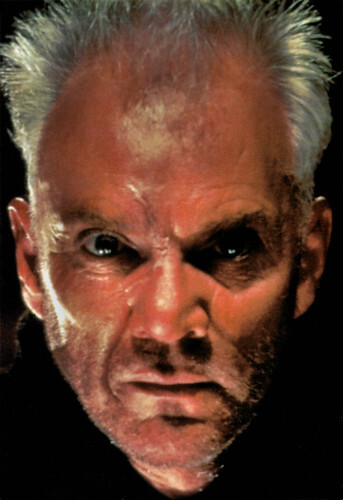
American postcard by Classico San Francisco, no. 105-350. Photo: Paramount Pictures. Malcolm McDowell in Star Trek - Generations (David Carson, 1994).
A juvenile criminal who ends up killing
Malcolm McDowell was born Malcolm John Taylor in Horsforth in the City of Leeds, West Yorkshire, Great Britain, in 1943. He was the eldest of three children of Edna McDowell and Charles Taylor. After him, his sisters Gloria and Judy were born. Father Taylor was an RAF officer and moved to Bridlington with his family. They then moved to Liverpool, where McDowell grew up and as a teenager took a job in a Planters nut factory in nearby Aintree, as well as working at his father's pub, The Bull and Dog, in Burscough, Lancashire.
Malcolm attended a public school in England from the age of 11. At school, he was beaten with a slipper or cane every Monday for his wayward behaviour. There he decided that he wanted to become an actor, and studied acting at the London Academy of Music and Dramatic Arts (LAMDA). Meanwhile, he worked at his parents' pub but lost his job when the pub went bankrupt. His alcoholic father drank all the profits. He then had a variety of jobs, from coffee salesman to messenger. McDowell gained experience as an actor as an extra with the Royal Shakespeare Company.
His first film role was in the first feature-length film from director Ken Loach, Poor Cow (Ken Loach, 1967) with Terence Stamp , but his scene was eventually cut from the film. Moving to New York, McDowell met director Lindsay Anderson and appeared in his off-Broadway production of 'Look Back in Anger'. After this, Anderson selected him to star as Mick Travis, the rebellious boarding school student in If... (Lindsay Anderson, 1968). In this film, Mick, along with two fellow students, ends up taking the parents and teachers under fire with automatic weapons. As he wanted to get into the SAG, the British Actors' Equity, he took his mother's maiden name McDowell because there was another British actor called Malcolm Taylor.
While McDowell played roles in two other films, If.... premiered. Director Stanley Kubrick who was looking for the lead actor for his film A Clockwork Orange (1971), based upon the novel by Anthony Burgess, was very interested in McDowell. The role of Alex DeLarge is that of a psychopath, a juvenile criminal who ends up killing. The nervous McDowell, who was unsure how to play Alex, asked Lindsay Anderson for advice on how to fill his role at the audition. Anderson advised McDowell to stay close to the role of Mick Travis with his mean smile. Kubrick was deeply impressed and gave McDowell the role of Alex. The portrayal of the role of Alex earned McDowell a Golden Globe nomination. In his All Movie review, Mark Deming notes: "For all its horrific violence and troubling moral ambiguity, it is ultimately a satire, and, like Dr. Strangelove, it wrings a shocking amount of humor from situations that few people would think of as funny. With the notable exception of Alex (Malcolm McDowell in the best performance of his career), most of the characters are little more than cartoons (with dialogue to match), while a great deal of the violence walks a fine line between Looney Tunes absurdity and crushingly vivid brutality."
After the success of A Clockwork Orange, McDowell received several offers. He again chose director Lindsay Anderson and made the semi-autobiographical O Lucky Man! (1973) with him, a film based on suggestions by McDowell. In 1982, he collaborated with Anderson for the third time in Britannia Hospital (Lindsay Anderson, 1982). In the 1970s, he also starred frequently in British television productions, mostly adaptations of plays such as The Collection (1976) with Laurence Olivier . He also featured in British films such as the adventure satire Royal Flash (Richard Lester, 1975), the WWI drama Aces High (Jack Gold, 1975), the disaster film Voyage of the Damned (Stuart Rosenberg, 1976) with Faye Dunaway and the TV film She Fell Among Thieves (Clive Donner, 1977). Pedro Borges at IMDb : "In early 1976, he spent nearly a year working on what would later be one of the most infamous films of all time, the semi-pornographic Caligula (Tinto Brass, 1979), financed by Penthouse magazine founder Bob Guccione. Around that time, the British film industry collapsed, forcing him to flee to America to continue working."
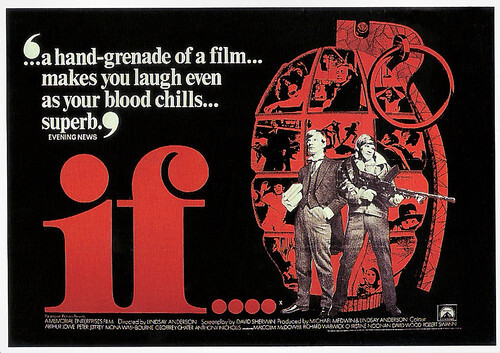
British postcard by Paramount Pictures for the DVD release (2007), no. GI101327PK. Photo: Paramount Pictures. Poster for If... (Lindsay Anderson, 1968).
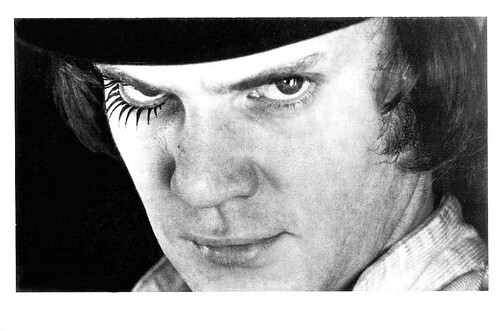
Vintage postcard. Malcolm McDowell in A Clockwork Orange (Stanley Kubrick, 1971).
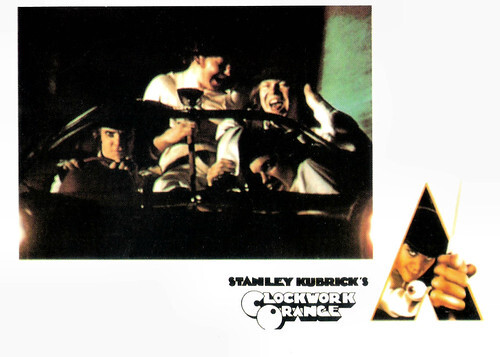
French postcard. Malcolm McDowell, Warren Clarke, Michael Tarn and James Marcus in A Clockwork Orange (Stanley Kubrick, 1971).
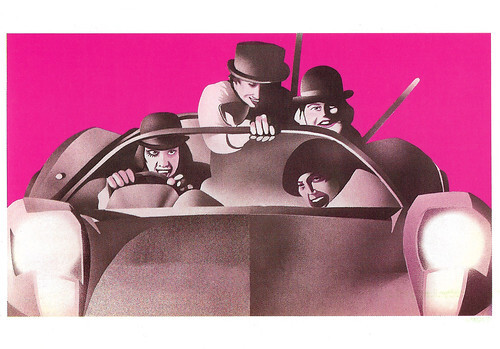
Vintage postcard by Memory Card, no. 690. Malcolm McDowell, Warren Clarke, Michael Tarn and James Marcus in A Clockwork Orange (Stanley Kubrick, 1971).
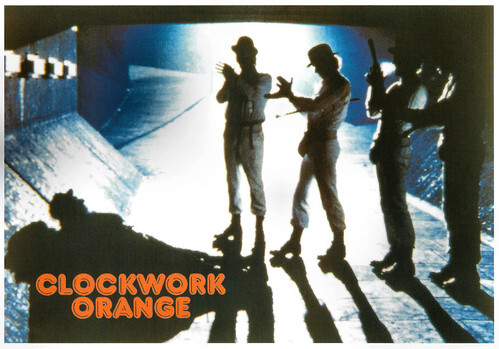
Vintage postcard by Memory Card, no. 473. Malcolm McDowell, Warren Clarke, Paul Farrell, Michael Tarn and James Marcus in A Clockwork Orange (Stanley Kubrick, 1971).
Still commanding the screen
Malcolm McDowell played the role of British writer H.G. Wells in Time After Time (Nicholas Meyer, 1979). It was his first American film. During this production, he met his second wife, actress Mary Steenburgen. He divorced his first wife, Margot Bennett, in 1980 and married Steenburgen. He made his mark in some good films like the action thriller Blue Thunder (John Badham, 1983) in which he played the repulsive helicopter pilot F.E. Cochrane. He played opposite Nastassja Kinski in the supernatural Horror film Cat People (Paul Schrader, 1982) and parodied Rolling Stones singer Mick Jagger in Get Crazy (Allan Arkush, 1983).
In the mid-1980s, the years of alcohol and drug abuse, including $1000 a week on cocaine, took its toll on him. His black hair was now grey. Looking older than he was, nobody wanted to cast him for playing younger roles. The big roles having dried up, he did many B-films, many of which did not even make it to cinemas. This damaged McDowell's reputation as an artist.
In the 1990s, McDowell overcame his alcohol addiction. He divorced Mary Steenburgen and in 1991, he married Kelley Kuhr, twenty-four years younger. In 1994, he played Dr. Tolian Soran, in Star Trek: Generations (David Carson, 1994), a role that put him back on the map. Dr Soran is a mad scientist who murders the beloved Captain Kirk. Meanwhile older and more content with himself, McDowell played such diverse films as The Player (Robert Altman, 1992) and the post-apocalyptic Science-Fiction film Tank Girl (Rachel Talalay, 1995). He also collaborated on an episode of the animated series South Park (2000). He was the first well-known actor to appear in the flesh in a South Park parody of Charles Dickens 's classic 'Great Expectations', playing the narrator and simply calling himself "A British Person".
McDowell continued his career in the 21st century. In Robert Altman's drama The Company (Robert Altman, 2003), he played the director of the Joffrey Ballet. He was a man who took the law into his own hands in I'll Sleep When I'm Dead (Mike Hodges, 2003) starring Clive Owen. He remained active in television productions, playing roles in Law & Order: Criminal Intent, Heroes and Masters of Science Fiction on Sky. He played Dr. Samuel Loomis in the remake of Halloween (Rob Zombie, 2007) and its sequel, Halloween II (Rob Zombie, 2009). He made a brief but memorable performance in the award-winning French film The Artist (Michel Hazanavicius, 2011), a comedy-drama film in the style of a silent film. It was nominated for ten Academy Awards and won five, including Best Picture.
His performance proved that even without so much as a line of dialogue, McDowell still had the charisma to command the screen. He played Rupert Murdoch in the American drama Bombshell (Jay Roach, 2019) with Charlize Theron, Nicole Kidman , and Margot Robbie. The film was based on the accounts of the women at Fox News who set out to expose CEO Roger Ailes for sexual harassment. McDowell has played Patrick "Pop" Critch on the Canadian series Son of a Critch since 2022. Malcolm McDowell has five children and a granddaughter. He has two children with Mary Steenburgen, Lilly (born 1981) and filmmaker Charlie McDowell (1983). He has three sons with his wife Kelley McDowell: Beckett Taylor McDowell (2004), Finnian Anderson McDowell (2006), and Seamus Hudson McDowell (2009). In 2021, McDowell announced that he had become an American citizen.
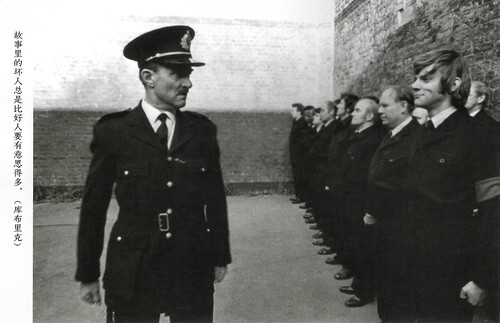
Chinese postcard. Michael Bates and Malcolm McDowell in A Clockwork Orange (Stanley Kubrick, 1971).
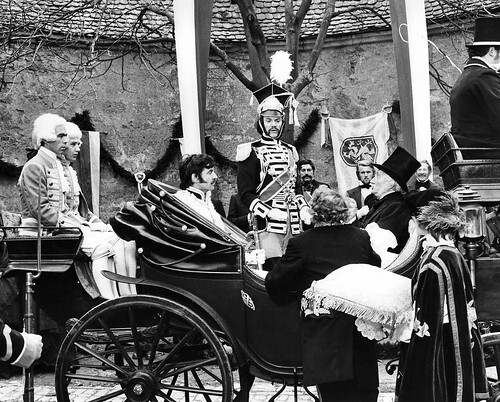
Vintage press photo. Malcolm McDowell in Royal Flash (Richard Lester, 1975).
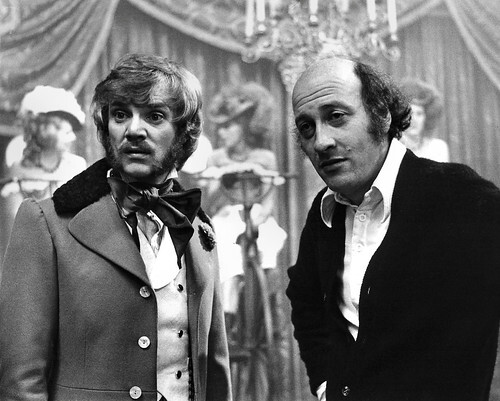
Vintage press photo. Malcolm McDowell and director Richard Lester on the set of Royal Flash (Richard Lester, 1975).
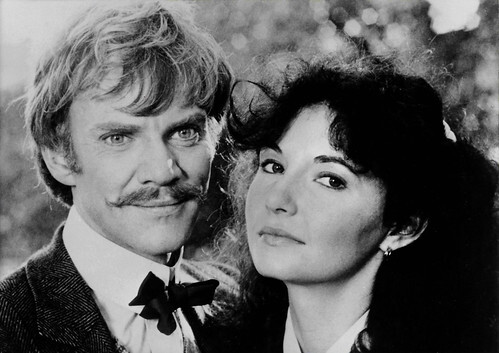
German press photo by ORF Fotodienst, 1986. Malcolm McDowell and Mary Steenbergen in Time After Time (Nicholas Meyer, 1979).
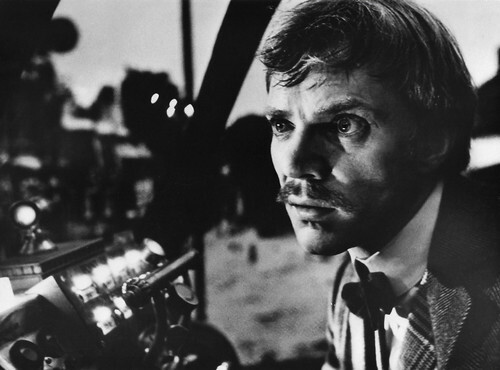
German press photo. Photo: Warner Bros. / Orion. Malcolm McDowell in Time After Time (Nicholas Meyer, 1979).
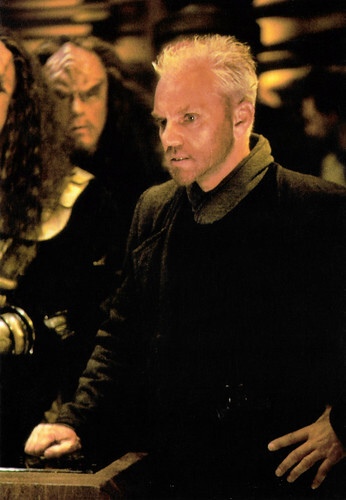
American postcard by Classico San Francisco, no. 105-364. Photo: Paramount Pictures. Malcolm McDowell in Star Trek - Generations (David Carson, 1994).
Sources: (IMDb), Mark Deming (AllMovie), AllMovie, Wikipedia (Dutch and English) and .

Vintage postcard by Memory Card, no. 475. Malcolm McDowell, Warren Clarke, Paul Farrell, Michael Tarn and James Marcus in A Clockwork Orange (Stanley Kubrick, 1971).

British postcard by Paramount Pictures for the DVD release (2007), no. GI101327PK. Photo: Paramount Pictures. Malcolm McDowell in If... (Lindsay Anderson, 1968).

Vintage photo. Malcolm McDowell and Alan Bates in Royal Flash (Richard Lester, 1975).

German press photo by UIP Filmverleih, no. P3. Malcolm McDowell in Cat People (Paul Schrader, 1982).

American postcard by Classico San Francisco, no. 105-350. Photo: Paramount Pictures. Malcolm McDowell in Star Trek - Generations (David Carson, 1994).
A juvenile criminal who ends up killing
Malcolm McDowell was born Malcolm John Taylor in Horsforth in the City of Leeds, West Yorkshire, Great Britain, in 1943. He was the eldest of three children of Edna McDowell and Charles Taylor. After him, his sisters Gloria and Judy were born. Father Taylor was an RAF officer and moved to Bridlington with his family. They then moved to Liverpool, where McDowell grew up and as a teenager took a job in a Planters nut factory in nearby Aintree, as well as working at his father's pub, The Bull and Dog, in Burscough, Lancashire.
Malcolm attended a public school in England from the age of 11. At school, he was beaten with a slipper or cane every Monday for his wayward behaviour. There he decided that he wanted to become an actor, and studied acting at the London Academy of Music and Dramatic Arts (LAMDA). Meanwhile, he worked at his parents' pub but lost his job when the pub went bankrupt. His alcoholic father drank all the profits. He then had a variety of jobs, from coffee salesman to messenger. McDowell gained experience as an actor as an extra with the Royal Shakespeare Company.
His first film role was in the first feature-length film from director Ken Loach, Poor Cow (Ken Loach, 1967) with Terence Stamp , but his scene was eventually cut from the film. Moving to New York, McDowell met director Lindsay Anderson and appeared in his off-Broadway production of 'Look Back in Anger'. After this, Anderson selected him to star as Mick Travis, the rebellious boarding school student in If... (Lindsay Anderson, 1968). In this film, Mick, along with two fellow students, ends up taking the parents and teachers under fire with automatic weapons. As he wanted to get into the SAG, the British Actors' Equity, he took his mother's maiden name McDowell because there was another British actor called Malcolm Taylor.
While McDowell played roles in two other films, If.... premiered. Director Stanley Kubrick who was looking for the lead actor for his film A Clockwork Orange (1971), based upon the novel by Anthony Burgess, was very interested in McDowell. The role of Alex DeLarge is that of a psychopath, a juvenile criminal who ends up killing. The nervous McDowell, who was unsure how to play Alex, asked Lindsay Anderson for advice on how to fill his role at the audition. Anderson advised McDowell to stay close to the role of Mick Travis with his mean smile. Kubrick was deeply impressed and gave McDowell the role of Alex. The portrayal of the role of Alex earned McDowell a Golden Globe nomination. In his All Movie review, Mark Deming notes: "For all its horrific violence and troubling moral ambiguity, it is ultimately a satire, and, like Dr. Strangelove, it wrings a shocking amount of humor from situations that few people would think of as funny. With the notable exception of Alex (Malcolm McDowell in the best performance of his career), most of the characters are little more than cartoons (with dialogue to match), while a great deal of the violence walks a fine line between Looney Tunes absurdity and crushingly vivid brutality."
After the success of A Clockwork Orange, McDowell received several offers. He again chose director Lindsay Anderson and made the semi-autobiographical O Lucky Man! (1973) with him, a film based on suggestions by McDowell. In 1982, he collaborated with Anderson for the third time in Britannia Hospital (Lindsay Anderson, 1982). In the 1970s, he also starred frequently in British television productions, mostly adaptations of plays such as The Collection (1976) with Laurence Olivier . He also featured in British films such as the adventure satire Royal Flash (Richard Lester, 1975), the WWI drama Aces High (Jack Gold, 1975), the disaster film Voyage of the Damned (Stuart Rosenberg, 1976) with Faye Dunaway and the TV film She Fell Among Thieves (Clive Donner, 1977). Pedro Borges at IMDb : "In early 1976, he spent nearly a year working on what would later be one of the most infamous films of all time, the semi-pornographic Caligula (Tinto Brass, 1979), financed by Penthouse magazine founder Bob Guccione. Around that time, the British film industry collapsed, forcing him to flee to America to continue working."

British postcard by Paramount Pictures for the DVD release (2007), no. GI101327PK. Photo: Paramount Pictures. Poster for If... (Lindsay Anderson, 1968).

Vintage postcard. Malcolm McDowell in A Clockwork Orange (Stanley Kubrick, 1971).

French postcard. Malcolm McDowell, Warren Clarke, Michael Tarn and James Marcus in A Clockwork Orange (Stanley Kubrick, 1971).

Vintage postcard by Memory Card, no. 690. Malcolm McDowell, Warren Clarke, Michael Tarn and James Marcus in A Clockwork Orange (Stanley Kubrick, 1971).

Vintage postcard by Memory Card, no. 473. Malcolm McDowell, Warren Clarke, Paul Farrell, Michael Tarn and James Marcus in A Clockwork Orange (Stanley Kubrick, 1971).
Still commanding the screen
Malcolm McDowell played the role of British writer H.G. Wells in Time After Time (Nicholas Meyer, 1979). It was his first American film. During this production, he met his second wife, actress Mary Steenburgen. He divorced his first wife, Margot Bennett, in 1980 and married Steenburgen. He made his mark in some good films like the action thriller Blue Thunder (John Badham, 1983) in which he played the repulsive helicopter pilot F.E. Cochrane. He played opposite Nastassja Kinski in the supernatural Horror film Cat People (Paul Schrader, 1982) and parodied Rolling Stones singer Mick Jagger in Get Crazy (Allan Arkush, 1983).
In the mid-1980s, the years of alcohol and drug abuse, including $1000 a week on cocaine, took its toll on him. His black hair was now grey. Looking older than he was, nobody wanted to cast him for playing younger roles. The big roles having dried up, he did many B-films, many of which did not even make it to cinemas. This damaged McDowell's reputation as an artist.
In the 1990s, McDowell overcame his alcohol addiction. He divorced Mary Steenburgen and in 1991, he married Kelley Kuhr, twenty-four years younger. In 1994, he played Dr. Tolian Soran, in Star Trek: Generations (David Carson, 1994), a role that put him back on the map. Dr Soran is a mad scientist who murders the beloved Captain Kirk. Meanwhile older and more content with himself, McDowell played such diverse films as The Player (Robert Altman, 1992) and the post-apocalyptic Science-Fiction film Tank Girl (Rachel Talalay, 1995). He also collaborated on an episode of the animated series South Park (2000). He was the first well-known actor to appear in the flesh in a South Park parody of Charles Dickens 's classic 'Great Expectations', playing the narrator and simply calling himself "A British Person".
McDowell continued his career in the 21st century. In Robert Altman's drama The Company (Robert Altman, 2003), he played the director of the Joffrey Ballet. He was a man who took the law into his own hands in I'll Sleep When I'm Dead (Mike Hodges, 2003) starring Clive Owen. He remained active in television productions, playing roles in Law & Order: Criminal Intent, Heroes and Masters of Science Fiction on Sky. He played Dr. Samuel Loomis in the remake of Halloween (Rob Zombie, 2007) and its sequel, Halloween II (Rob Zombie, 2009). He made a brief but memorable performance in the award-winning French film The Artist (Michel Hazanavicius, 2011), a comedy-drama film in the style of a silent film. It was nominated for ten Academy Awards and won five, including Best Picture.
His performance proved that even without so much as a line of dialogue, McDowell still had the charisma to command the screen. He played Rupert Murdoch in the American drama Bombshell (Jay Roach, 2019) with Charlize Theron, Nicole Kidman , and Margot Robbie. The film was based on the accounts of the women at Fox News who set out to expose CEO Roger Ailes for sexual harassment. McDowell has played Patrick "Pop" Critch on the Canadian series Son of a Critch since 2022. Malcolm McDowell has five children and a granddaughter. He has two children with Mary Steenburgen, Lilly (born 1981) and filmmaker Charlie McDowell (1983). He has three sons with his wife Kelley McDowell: Beckett Taylor McDowell (2004), Finnian Anderson McDowell (2006), and Seamus Hudson McDowell (2009). In 2021, McDowell announced that he had become an American citizen.

Chinese postcard. Michael Bates and Malcolm McDowell in A Clockwork Orange (Stanley Kubrick, 1971).

Vintage press photo. Malcolm McDowell in Royal Flash (Richard Lester, 1975).

Vintage press photo. Malcolm McDowell and director Richard Lester on the set of Royal Flash (Richard Lester, 1975).

German press photo by ORF Fotodienst, 1986. Malcolm McDowell and Mary Steenbergen in Time After Time (Nicholas Meyer, 1979).

German press photo. Photo: Warner Bros. / Orion. Malcolm McDowell in Time After Time (Nicholas Meyer, 1979).

American postcard by Classico San Francisco, no. 105-364. Photo: Paramount Pictures. Malcolm McDowell in Star Trek - Generations (David Carson, 1994).
Sources: (IMDb), Mark Deming (AllMovie), AllMovie, Wikipedia (Dutch and English) and .
Published on February 01, 2024 22:00
January 31, 2024
Potiche (2010)
Potiche (2010) is a Belgian-French comedy of manners written and directed by François Ozon. It stars Catherine Deneuve, Gérard Depardieu, Fabrice Luchini, Karin Viard, Judith Godrèche and Jérémie Renier. Set in 1977, the film is based on the play of the same name by Pierre Barillet and Jean-Pierre Grédy. To create a detached, fiction-oriented effect, Ozon retained some theatrical conventions.
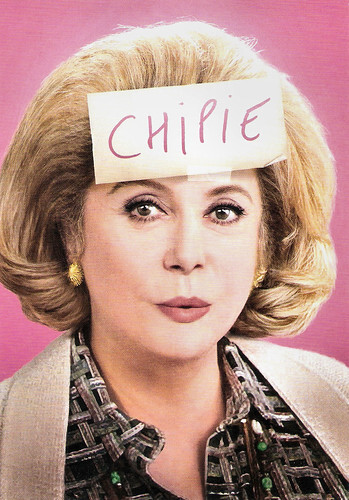
Belgian Freecard by Boomerang. Photo: Mandarin Cinema. Catherine Deneuve in Potiche/Trophy Wife (François Ozon, 2010). Caption: Chipie.

Belgian Freecard by Boomerang. Photo: Mandarin Cinema. Gérard Depardieu in Potiche/Trophy Wife (François Ozon, 2010). Caption: Mother's child.
A biographical film about Nicolas Sarkozy
'Potiche' is the French word for 'ornamental vase', but also for 'showpiece' and 'trophy wife'. Set in 1977, Potiche is situated in the northern French town of Sainte-Gudule, close to Saint-Amand-les-Eaux. There live wealthy industrialist Robert Pujol (Fabrice Luchini) and his wife Suzanne Pujol ( Catherine Deneuve ), a grandmother who has been a housewife for 30 years.
Suzanne's father was the founder of a successful umbrella company, which was later taken over by her reactionary and misogynist husband. Suzanne, nicknamed "la potiche" by her daughter (Juliette Godreche), puts up with her husband's bad temper, vexations and infidelities without batting an eyelid, not least his relationship with his secretary, Nadège (Karin Viard).
Robert tyrannises his factory workers and they decide to go on strike for better working conditions and kidnap him. When Robert also suffers a heart attack due to all the stress, all hell breaks loose. Suzanne is forced to take over her husband's work with the help of her ex-lover and current union leader and village mayor Maurice ( Gérard Depardieu ). To everyone's surprise, Suzanne emerges as a real businesswoman who knows how to handle everything. But then Robert returns from holiday fully recovered and things get really complicated.
François Ozon saw the play 'Potiche' by Pierre Barillet and Jean-Pierre Grédy about ten years before he made the film. The political career of Suzanne was entirely Ozon's addition to the story, which in its original incarnation ended when Robert returned to the factory. According to Ozon, the genesis of the film version was, partly, that he had been approached by the producers Éric and Nicolas Altmayer and asked to make a biographical film about Nicolas Sarkozy, and, partly, his experiences from the 2007 presidential campaign, where he followed the Socialist Party's candidate Ségolène Royal.
While writing the screenplay, Ozon regularly met with Barillet, who gladly approved the tweaks made to enhance the story's relevance for contemporary society. The 1970s setting was, however, retained; this was both because the distance allowed the director to make a more humorous film, and because France was more politically divided in the 1970s, which made the class relations more remarkable.
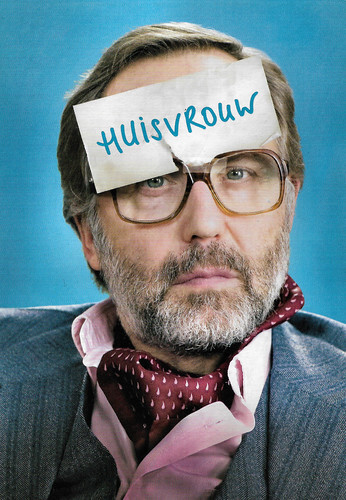
Belgian Freecard by Boomerang. Photo: Mandarin Cinema. Fabrice Luchini in Potiche/Trophy Wife (François Ozon, 2010). Caption: Housewife.
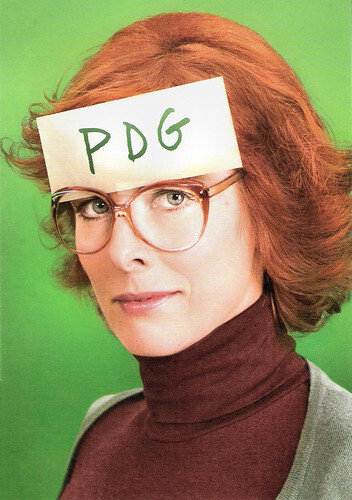
Belgian Freecard by Boomerang. Photo: Mandarin Cinema / Cinéart. Karin Viard in Potiche/Trophy Wife (François Ozon, 2010). Caption: PDG (CEO).
A sweet comedy, knowing about human nature
Potiche was produced by Mandarin Cinéma, with co-production support from Production Services Belgium. The film was deliberately given a theatrical look to create distance and give the audience a constant awareness of watching a work of fiction. An important influence on the visual style was the cinema of Jacques Demy.
The soundtrack includes Michèle Torr with 'Emmène-moi danser ce soir', 'Il était une fois', 'Viens faire un tour sous la pluie' and Jean Ferrat's 'C'est beau la vie'. The film competed at the 67th Venice International Film Festival and received two Magritte Award nominations, winning Best Supporting Actor for Jérémie Renier, who plays Suzanne's son.
The film was fairly well received by critics and the French public. Roger Ebert liked the film: "Potiche is a whimsical comedy, based on a popular Parisian stage success of some years ago. It plays like one, although Ozon uses more locations than a play would find possible. There's little effort at psychological depth, and the characters float along on the requirements of comedy. But it's sweet comedy, knowing about human nature, and Deneuve and Depardieu, who bring so much history to the screen, seem to create it by their very natures."
At AllMovie , Mark Deming agrees: "François Ozon's handling of this material is inspired. While the political and feminist underpinnings of this story are treated with all the seriousness they deserve, Potiche is first and foremost entertainment, and Ozon keeps the story moving at a brisk pace, gives it a glossy visual style that honors the era in which the story takes place without turning it tacky or silly, and reminds us that a good farce needs to communicate to the heart and mind as well as the funny bone. If Potiche works as a feminist document, it's because Ozon's story (he wrote the screenplay, adapted from a play by Pierre Barillet and Jean-Pierre Grédy) shows how a woman can discover her strengths under unlikely circumstances, and here Suzanne's wisdom is never questioned -- the surprise is how she's finally permitted to do something worthwhile with it."
Over two million tickets were sold for Potiche in France. The budget of the film was ca. 13 million dollars and the international revenues were nearly 29 million dollars.
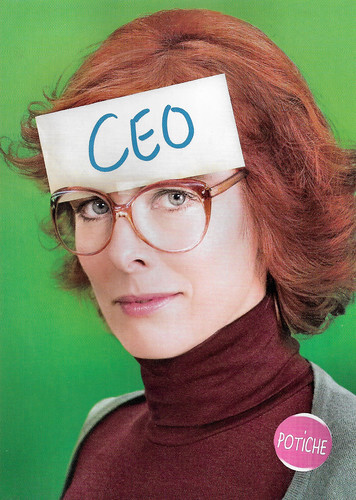
Dutch Freecard by Boomerang, no. P 25-10. Photo: Cinéart / Senz. Karin Viard in Potiche/Trophy Wife (François Ozon, 2010). Caption: CEO.
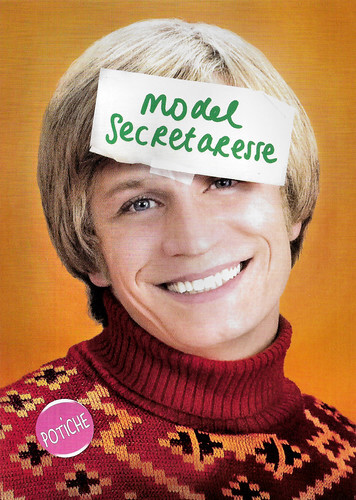
Dutch Freecard by Boomerang, no. P25-10. Photo: Cineart / Senz. Jérémie Renier in Potiche/Trophy Wife (François Ozon, 2010). Caption: Model secretary.
Sources: Roger Ebert (RogerEbert.com), Mark Deming (AllMovie), Wikipedia (Dutch, English and French) and IMDb.

Belgian Freecard by Boomerang. Photo: Mandarin Cinema. Catherine Deneuve in Potiche/Trophy Wife (François Ozon, 2010). Caption: Chipie.

Belgian Freecard by Boomerang. Photo: Mandarin Cinema. Gérard Depardieu in Potiche/Trophy Wife (François Ozon, 2010). Caption: Mother's child.
A biographical film about Nicolas Sarkozy
'Potiche' is the French word for 'ornamental vase', but also for 'showpiece' and 'trophy wife'. Set in 1977, Potiche is situated in the northern French town of Sainte-Gudule, close to Saint-Amand-les-Eaux. There live wealthy industrialist Robert Pujol (Fabrice Luchini) and his wife Suzanne Pujol ( Catherine Deneuve ), a grandmother who has been a housewife for 30 years.
Suzanne's father was the founder of a successful umbrella company, which was later taken over by her reactionary and misogynist husband. Suzanne, nicknamed "la potiche" by her daughter (Juliette Godreche), puts up with her husband's bad temper, vexations and infidelities without batting an eyelid, not least his relationship with his secretary, Nadège (Karin Viard).
Robert tyrannises his factory workers and they decide to go on strike for better working conditions and kidnap him. When Robert also suffers a heart attack due to all the stress, all hell breaks loose. Suzanne is forced to take over her husband's work with the help of her ex-lover and current union leader and village mayor Maurice ( Gérard Depardieu ). To everyone's surprise, Suzanne emerges as a real businesswoman who knows how to handle everything. But then Robert returns from holiday fully recovered and things get really complicated.
François Ozon saw the play 'Potiche' by Pierre Barillet and Jean-Pierre Grédy about ten years before he made the film. The political career of Suzanne was entirely Ozon's addition to the story, which in its original incarnation ended when Robert returned to the factory. According to Ozon, the genesis of the film version was, partly, that he had been approached by the producers Éric and Nicolas Altmayer and asked to make a biographical film about Nicolas Sarkozy, and, partly, his experiences from the 2007 presidential campaign, where he followed the Socialist Party's candidate Ségolène Royal.
While writing the screenplay, Ozon regularly met with Barillet, who gladly approved the tweaks made to enhance the story's relevance for contemporary society. The 1970s setting was, however, retained; this was both because the distance allowed the director to make a more humorous film, and because France was more politically divided in the 1970s, which made the class relations more remarkable.

Belgian Freecard by Boomerang. Photo: Mandarin Cinema. Fabrice Luchini in Potiche/Trophy Wife (François Ozon, 2010). Caption: Housewife.

Belgian Freecard by Boomerang. Photo: Mandarin Cinema / Cinéart. Karin Viard in Potiche/Trophy Wife (François Ozon, 2010). Caption: PDG (CEO).
A sweet comedy, knowing about human nature
Potiche was produced by Mandarin Cinéma, with co-production support from Production Services Belgium. The film was deliberately given a theatrical look to create distance and give the audience a constant awareness of watching a work of fiction. An important influence on the visual style was the cinema of Jacques Demy.
The soundtrack includes Michèle Torr with 'Emmène-moi danser ce soir', 'Il était une fois', 'Viens faire un tour sous la pluie' and Jean Ferrat's 'C'est beau la vie'. The film competed at the 67th Venice International Film Festival and received two Magritte Award nominations, winning Best Supporting Actor for Jérémie Renier, who plays Suzanne's son.
The film was fairly well received by critics and the French public. Roger Ebert liked the film: "Potiche is a whimsical comedy, based on a popular Parisian stage success of some years ago. It plays like one, although Ozon uses more locations than a play would find possible. There's little effort at psychological depth, and the characters float along on the requirements of comedy. But it's sweet comedy, knowing about human nature, and Deneuve and Depardieu, who bring so much history to the screen, seem to create it by their very natures."
At AllMovie , Mark Deming agrees: "François Ozon's handling of this material is inspired. While the political and feminist underpinnings of this story are treated with all the seriousness they deserve, Potiche is first and foremost entertainment, and Ozon keeps the story moving at a brisk pace, gives it a glossy visual style that honors the era in which the story takes place without turning it tacky or silly, and reminds us that a good farce needs to communicate to the heart and mind as well as the funny bone. If Potiche works as a feminist document, it's because Ozon's story (he wrote the screenplay, adapted from a play by Pierre Barillet and Jean-Pierre Grédy) shows how a woman can discover her strengths under unlikely circumstances, and here Suzanne's wisdom is never questioned -- the surprise is how she's finally permitted to do something worthwhile with it."
Over two million tickets were sold for Potiche in France. The budget of the film was ca. 13 million dollars and the international revenues were nearly 29 million dollars.

Dutch Freecard by Boomerang, no. P 25-10. Photo: Cinéart / Senz. Karin Viard in Potiche/Trophy Wife (François Ozon, 2010). Caption: CEO.

Dutch Freecard by Boomerang, no. P25-10. Photo: Cineart / Senz. Jérémie Renier in Potiche/Trophy Wife (François Ozon, 2010). Caption: Model secretary.
Sources: Roger Ebert (RogerEbert.com), Mark Deming (AllMovie), Wikipedia (Dutch, English and French) and IMDb.
Published on January 31, 2024 22:00
January 30, 2024
Sandra Milo (1933-2024)
Italian actress Sandra Milo (1933-2024), who passed away on Monday 29 January, was best known for her roles in Federico Fellini's 8½ (1963) and Giulietta degli spiriti/Juliet of the Spirits (1965), but she also worked with the famous directors Antonio Pietrangeli and Roberto Rossellini. She won the Silver Ribbon Best Supporting Actress award for both 8½ and Juliet of the Spirits. Sandra Milo was 90.
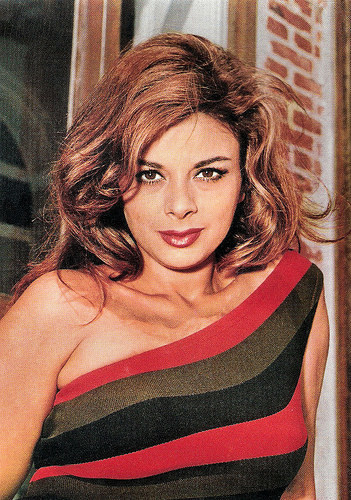
Italian postcard by Rotalfoto, no. 98.
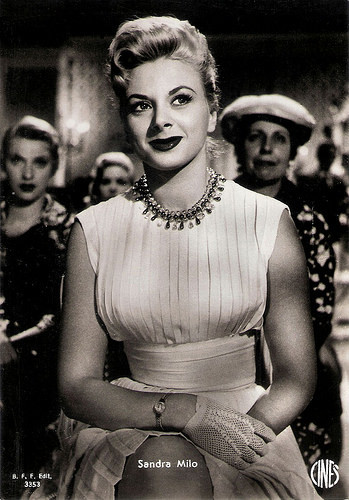
Italian postcard by B.F.F. Edit., no. 3353. Photo: Cines.
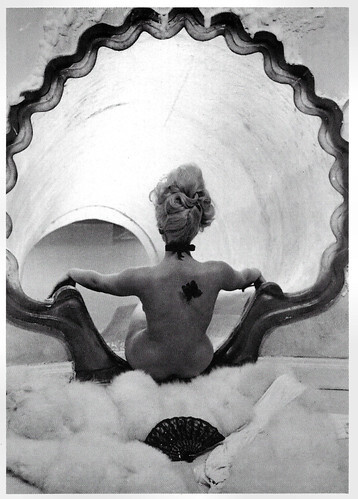
Swiss-German-British postcard by News Productions, Baulmes / Filmwelt Berlin, Bakede / News Productions, Stroud, no. 56522. Photo: Collection Cinémathèque Suisse, Lausanne. Sandra Milo in Giulietta Degli Spiriti/Juliet of the Spirits (Federico Fellini, 1965) produced by Rizzoli.
Saucy comedies and steamy melodramas
Sandra Milo was born Elena Salvatrice Greco in Tunis, Tunisia in 1933. She made her film debut alongside Alberto Sordi in Lo scapolo/The Bachelor (Antonio Pietrangeli, 1955). Milo mostly performed in saucy comedies and steamy melodramas.
Such films included Mio figlio Nerone/Nero's Mistress (Steno, 1956) with Alberto Sordi and Gloria Swanson , Les aventures d'Arsène Lupin/The Adventures of Arsène Lupin (Jacques Becker, 1957) with Robert Lamoureux , Le miroir à deux faces/The Mirror Has Two Faces (André Cayate, 1958) starring Michèle Morgan , and Totò nella luna/Toto in the Moon (Steno, 1958) with Totò and Sylva Koscina .
Gary Brumburgh at IMDb : “Bosomy, scintillating, dark-haired Tunisian leading lady Sandra Milo played bored patricians, manipulative mistresses and other enticing ladies of questionable morals with typical sensuous flare.”
Her first major role came thanks to the producer Moris Ergas, in Il generale Della Rovere/General Della Rovere (1959), directed by Roberto Rossellini and featuring Vittorio De Sica . She starred opposite Lino Ventura in two French thrillers, Un témoin dans la ville/Witness in the City (Edouard Molinaro, 1959), and Classe tous risques/The Big Risk (Claude Sautet, 1960).
Antonio Pietrangeli directed her again in Adua e le compagne/Adua and Her Friends (1960), a comedy about four unemployed prostitutes who decide to go into business running a restaurant, and in Fantasmi a Roma/Ghosts of Rome (1961), both with Marcello Mastroianni . She also appeared opposite Laurent Terzieff in Vanina Vanini (Roberto Rossellini, 1961), based on a short story by Stendhal. Rossellini's career was cut short after the film received harsh criticism at the Venice Festival. Milo married producer Moris Ergas with whom she had a daughter Deborah. After her marriage, she retired from her acting career.
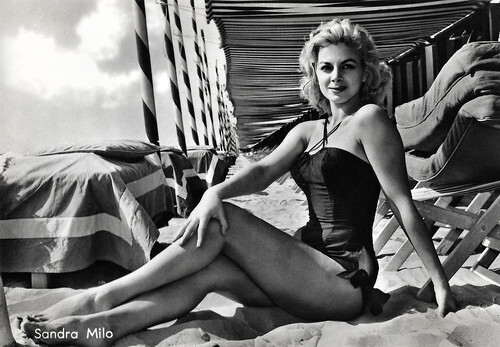
Italian postcard by Bromostampa, Milano, no. 152.
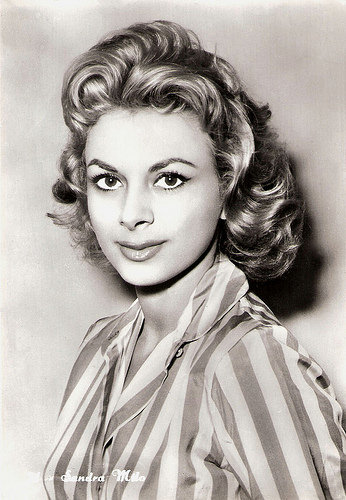
Italian postcard by Turismofoto, no. 71.
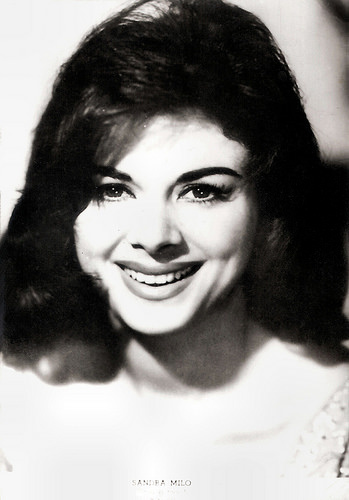
Small Romanian collectors card, no. 12.
A flesh and blood incarnation of Satan
Then Sandra Milo was discovered by Federico Fellini . Although she was reluctant to make a comeback, Fellini convinced Milo to take on the role of the sexy, lightheaded mistress opposite Marcello Mastroianni in 8½ (1963). 8½ won an Academy Award for Best Foreign-Language Film, as well as the Grand Prize at the Moscow Film Festival, and was one of the most influential and commercially successful European art movies of the 1960s.
After this success, she reunited with director Antonio Pietrangeli for La visita/The Visit (1963) with François Périer . Fellini then directed her opposite Giulietta Masina in Giulietta degli spiriti/Juliet of the Spirits (Federico Fellini, 1965). She played Giulietta’s neighbour, Suzy, a highly, eccentric pleasure-seeker who lives in a sensual playhouse and who may or may not be a flesh and blood incarnation of Satan.
David Anderson in his review at Bunched Undies : " Federico Fellini ’s Juliet of the Spirits remains one of the esteemed director’s most fanciful and entertaining films; its sparkling joys untarnished by the passage of time. (...) Clearly, Juliet of the Spirits is one of Italy’s first feminist films from a modern perspective. While Fellini made several films with Masina - and in all of them she faces significant obstacles - this is the first to loudly proclaim that a woman doesn’t necessarily need a husband to find happiness and, in some cases, she may be better off without one. "
Most of Milo’s following endeavours however were second-rate films. She retired again from acting in 1968, only to make a second comeback in 1979. Her roles shifted from that of the temptress to a more stern middle-aged woman. She appeared in Pupi Avati’s romantic drama Il Cuore Altrove/A Heart Elsewhere (2003) with Neri Marcoré and Giancarlo Giannini.
In 2006-2007 she toured Italy with the theatrical adaptation of 8 Femmes/8 Women. In her second marriage, she married Ottavio De Lollis with whom she had two sons, Ciro and Azzurra. Sandra Milo's last film was Il velo di Maya/The Veil of Maya (Elisabetta Rocchetti, 2017). Milo died on 29 January 2024, at the age of 90.
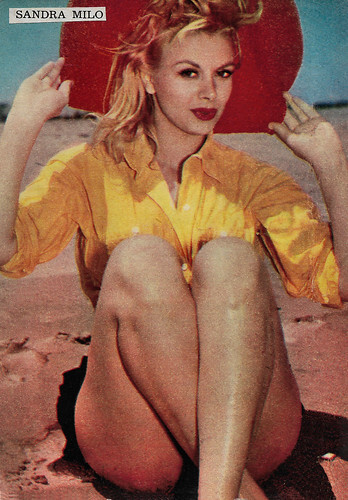
Italian postcard.
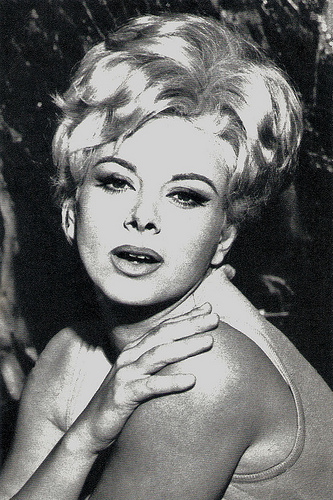
Romanian postcard by Casa Filmului Acin, no. 94.
DVD-trailer 8½ (1963). Source: Screenbound Pictures (YouTube).
Trailer Giulietta degli spiriti/Juliet of the Spirits (1965). Source: Argent Films (YouTube).
Sources: David Anderson (Bunched Undies), (IMDb), Hal Erickson (AllMovie), Wikipedia and .

Italian postcard by Rotalfoto, no. 98.

Italian postcard by B.F.F. Edit., no. 3353. Photo: Cines.

Swiss-German-British postcard by News Productions, Baulmes / Filmwelt Berlin, Bakede / News Productions, Stroud, no. 56522. Photo: Collection Cinémathèque Suisse, Lausanne. Sandra Milo in Giulietta Degli Spiriti/Juliet of the Spirits (Federico Fellini, 1965) produced by Rizzoli.
Saucy comedies and steamy melodramas
Sandra Milo was born Elena Salvatrice Greco in Tunis, Tunisia in 1933. She made her film debut alongside Alberto Sordi in Lo scapolo/The Bachelor (Antonio Pietrangeli, 1955). Milo mostly performed in saucy comedies and steamy melodramas.
Such films included Mio figlio Nerone/Nero's Mistress (Steno, 1956) with Alberto Sordi and Gloria Swanson , Les aventures d'Arsène Lupin/The Adventures of Arsène Lupin (Jacques Becker, 1957) with Robert Lamoureux , Le miroir à deux faces/The Mirror Has Two Faces (André Cayate, 1958) starring Michèle Morgan , and Totò nella luna/Toto in the Moon (Steno, 1958) with Totò and Sylva Koscina .
Gary Brumburgh at IMDb : “Bosomy, scintillating, dark-haired Tunisian leading lady Sandra Milo played bored patricians, manipulative mistresses and other enticing ladies of questionable morals with typical sensuous flare.”
Her first major role came thanks to the producer Moris Ergas, in Il generale Della Rovere/General Della Rovere (1959), directed by Roberto Rossellini and featuring Vittorio De Sica . She starred opposite Lino Ventura in two French thrillers, Un témoin dans la ville/Witness in the City (Edouard Molinaro, 1959), and Classe tous risques/The Big Risk (Claude Sautet, 1960).
Antonio Pietrangeli directed her again in Adua e le compagne/Adua and Her Friends (1960), a comedy about four unemployed prostitutes who decide to go into business running a restaurant, and in Fantasmi a Roma/Ghosts of Rome (1961), both with Marcello Mastroianni . She also appeared opposite Laurent Terzieff in Vanina Vanini (Roberto Rossellini, 1961), based on a short story by Stendhal. Rossellini's career was cut short after the film received harsh criticism at the Venice Festival. Milo married producer Moris Ergas with whom she had a daughter Deborah. After her marriage, she retired from her acting career.

Italian postcard by Bromostampa, Milano, no. 152.

Italian postcard by Turismofoto, no. 71.

Small Romanian collectors card, no. 12.
A flesh and blood incarnation of Satan
Then Sandra Milo was discovered by Federico Fellini . Although she was reluctant to make a comeback, Fellini convinced Milo to take on the role of the sexy, lightheaded mistress opposite Marcello Mastroianni in 8½ (1963). 8½ won an Academy Award for Best Foreign-Language Film, as well as the Grand Prize at the Moscow Film Festival, and was one of the most influential and commercially successful European art movies of the 1960s.
After this success, she reunited with director Antonio Pietrangeli for La visita/The Visit (1963) with François Périer . Fellini then directed her opposite Giulietta Masina in Giulietta degli spiriti/Juliet of the Spirits (Federico Fellini, 1965). She played Giulietta’s neighbour, Suzy, a highly, eccentric pleasure-seeker who lives in a sensual playhouse and who may or may not be a flesh and blood incarnation of Satan.
David Anderson in his review at Bunched Undies : " Federico Fellini ’s Juliet of the Spirits remains one of the esteemed director’s most fanciful and entertaining films; its sparkling joys untarnished by the passage of time. (...) Clearly, Juliet of the Spirits is one of Italy’s first feminist films from a modern perspective. While Fellini made several films with Masina - and in all of them she faces significant obstacles - this is the first to loudly proclaim that a woman doesn’t necessarily need a husband to find happiness and, in some cases, she may be better off without one. "
Most of Milo’s following endeavours however were second-rate films. She retired again from acting in 1968, only to make a second comeback in 1979. Her roles shifted from that of the temptress to a more stern middle-aged woman. She appeared in Pupi Avati’s romantic drama Il Cuore Altrove/A Heart Elsewhere (2003) with Neri Marcoré and Giancarlo Giannini.
In 2006-2007 she toured Italy with the theatrical adaptation of 8 Femmes/8 Women. In her second marriage, she married Ottavio De Lollis with whom she had two sons, Ciro and Azzurra. Sandra Milo's last film was Il velo di Maya/The Veil of Maya (Elisabetta Rocchetti, 2017). Milo died on 29 January 2024, at the age of 90.

Italian postcard.

Romanian postcard by Casa Filmului Acin, no. 94.
DVD-trailer 8½ (1963). Source: Screenbound Pictures (YouTube).
Trailer Giulietta degli spiriti/Juliet of the Spirits (1965). Source: Argent Films (YouTube).
Sources: David Anderson (Bunched Undies), (IMDb), Hal Erickson (AllMovie), Wikipedia and .
Published on January 30, 2024 22:00
January 29, 2024
Jean Coquelin
French stage and film actor and theatre director Jean Coquelin (1865-1944) was the son of the famous stage actor Benoit Constant Coquelin and the nephew of Coquelin Cadet. He was known for such films as L'abbé Constantin (1925), La chanson du souvenir (1937) and Café de Paris (1938).
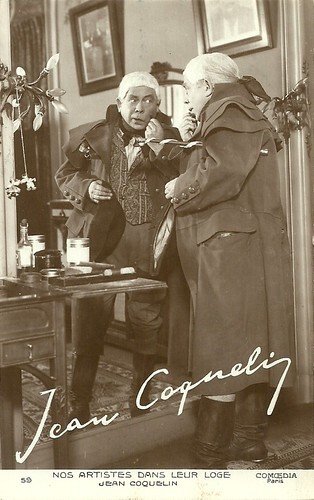
French postcard in the 'Nos artistes dans leur loge' series, no. 59. Photo: Comoedia, Paris.

French postcard, signed and dated 17 July 1902. Photo: Van Bosch, Paris. Caption: Coquelin de la Comédie Française.
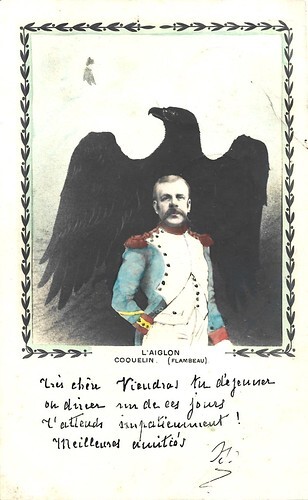
French postcard. Jean Coquelin as Flambeau in the play 'L'aiglon' by Edmond Rostand.
A debut at the Comédie Française
Jean Coquelin was born Camille Léon Jean Coquelin in 1865 in Paris, France. He was the son of the stage actor Benoit Constant Coquelin also known as Coquelin ainé and actress Antoine Mancy. His uncle, Coquelin Cadet, was also well-known actor.
He studied with Mme Arnould Plessy and Coquelin aîné, his father. He followed the latter on a major tour of Europe, and then entered the Comédie Française in 1890. He made his debut in 'Le Dépit amoureux', then played in 'Thermidor' and 'La Mégère apprivoisée'. He then moved on to the Renaissance Theatre.
In 1907, he became co-director of the Théâtre de la Gaité alongside Henry Hertz in 1907. In 1910, he and Hertz became the directors of the Théâtre de la Porte Saint-Martin, when Edmond Rostand's 'Chantecler' premiered there. That year, he married Blanche Miroir on 18 May 1910 in Neuilly sur Seine. His witnesses were Edmond Rostand and Albert Carré, and the bride's witnesses were Henry Hertz and Mme Michel.
At the Porte Saint-Martin, hee created the character of Raigoné in Edmond Rostand's 'Cyrano de Bergerac', the major play in which his father had performed.
Coquelin and his father played together in the stage play 'La Dame de Monsoreau', after a novel by Alexandre Dumas , turned into a stage play in 1860.
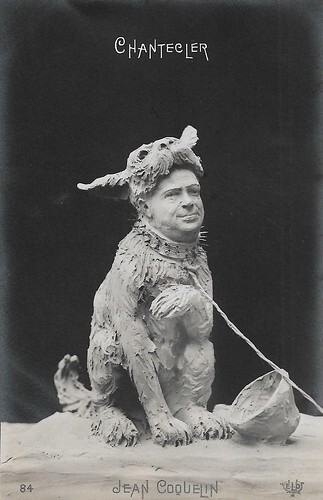
French postcard by ELD, no. 84. Jean Coquelin as the farmyard dog Patou in 'Chantecler', a play by Edmond Rostand.
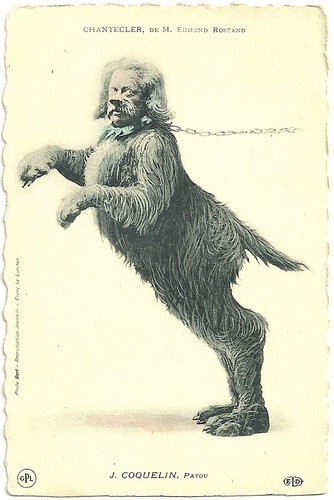
French postcard by ELD / GPL. Photo: Bert. Jean Coquelin as the farmyard dog Patou in 'Chantecler', a play by Edmond Rostand.
Clergyman
In 1925, after years of theatre performances, Jean Coquelin started to appear in film too. He made his debut in the lead role of the comedy Abbé Constantin/The Abbot Constantine (Julien Duvivier, 1925) with Claude France . He often played a clergyman such as the priest in La Roche aux Mouettes (Georges Monca, 1933).
Coquelin played several times with Julien Duvivier in such films as David Golder (Julien Duvivier, 1930) starring Harry Baur and La fin du jour/The End of the Day (Julien Duvivier, 1939) with Victor Francen and Michel Simon .
He even played more often with director Sacha Guitry and appeared in his films Faisons un reve/Let's Make a Dream (Sacha Guitry, 1937), Les perles de la couronne/The Pearls of the Crown (Christian-Jaque, Sacha Guitry, 1937), Remontons Les Champs-Elysées/Let's Go Up the Champs-Élysées (Sacha Guitry, Robert Bibal, 1938) and Le destin fabuleux de Désirée Clary/Mlle. Desiree (Sacha Guitry, 1942).
After his debut in a lead role, most of his roles were secondary characters or bit parts. His last role was a bit part in Maurice Tourneur's Les mains du diable/The Devil's Hand (Maurice Tourneur, 1943) with Pierre Fresnay , after the novel by Gérard de Nerval.
Jean Coquelin died in 1944 in Couilly-Pont-aux-Dames, Seine-et-Marne, France. He was 78. Coquelin was married to 'Blanche Miroir' and actress Louise Didès. With Didès, he had a son, actor Jean-Paul Coquelin.
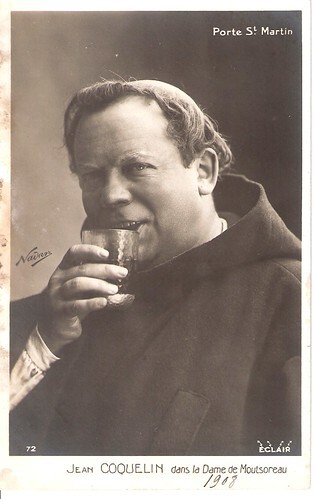
French postcard by Eclair. Photo: Atelier Nadar. Caption: Porte St. Martin. Jean Coquelin in the play 'La Dame de Monsoreau' (1908).
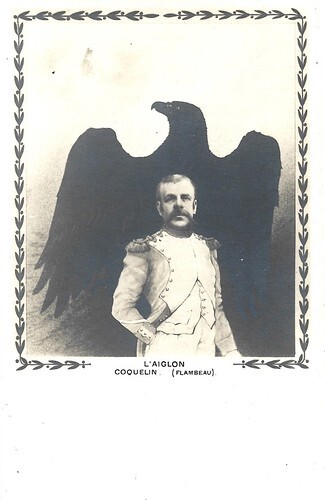
French postcard. Jean Coquelin as Flambeau in the play 'L'aiglon' by Edmond Rostand.
Sources: Theatredatabase, Wikipedia (French and English) and .

French postcard in the 'Nos artistes dans leur loge' series, no. 59. Photo: Comoedia, Paris.

French postcard, signed and dated 17 July 1902. Photo: Van Bosch, Paris. Caption: Coquelin de la Comédie Française.

French postcard. Jean Coquelin as Flambeau in the play 'L'aiglon' by Edmond Rostand.
A debut at the Comédie Française
Jean Coquelin was born Camille Léon Jean Coquelin in 1865 in Paris, France. He was the son of the stage actor Benoit Constant Coquelin also known as Coquelin ainé and actress Antoine Mancy. His uncle, Coquelin Cadet, was also well-known actor.
He studied with Mme Arnould Plessy and Coquelin aîné, his father. He followed the latter on a major tour of Europe, and then entered the Comédie Française in 1890. He made his debut in 'Le Dépit amoureux', then played in 'Thermidor' and 'La Mégère apprivoisée'. He then moved on to the Renaissance Theatre.
In 1907, he became co-director of the Théâtre de la Gaité alongside Henry Hertz in 1907. In 1910, he and Hertz became the directors of the Théâtre de la Porte Saint-Martin, when Edmond Rostand's 'Chantecler' premiered there. That year, he married Blanche Miroir on 18 May 1910 in Neuilly sur Seine. His witnesses were Edmond Rostand and Albert Carré, and the bride's witnesses were Henry Hertz and Mme Michel.
At the Porte Saint-Martin, hee created the character of Raigoné in Edmond Rostand's 'Cyrano de Bergerac', the major play in which his father had performed.
Coquelin and his father played together in the stage play 'La Dame de Monsoreau', after a novel by Alexandre Dumas , turned into a stage play in 1860.

French postcard by ELD, no. 84. Jean Coquelin as the farmyard dog Patou in 'Chantecler', a play by Edmond Rostand.

French postcard by ELD / GPL. Photo: Bert. Jean Coquelin as the farmyard dog Patou in 'Chantecler', a play by Edmond Rostand.
Clergyman
In 1925, after years of theatre performances, Jean Coquelin started to appear in film too. He made his debut in the lead role of the comedy Abbé Constantin/The Abbot Constantine (Julien Duvivier, 1925) with Claude France . He often played a clergyman such as the priest in La Roche aux Mouettes (Georges Monca, 1933).
Coquelin played several times with Julien Duvivier in such films as David Golder (Julien Duvivier, 1930) starring Harry Baur and La fin du jour/The End of the Day (Julien Duvivier, 1939) with Victor Francen and Michel Simon .
He even played more often with director Sacha Guitry and appeared in his films Faisons un reve/Let's Make a Dream (Sacha Guitry, 1937), Les perles de la couronne/The Pearls of the Crown (Christian-Jaque, Sacha Guitry, 1937), Remontons Les Champs-Elysées/Let's Go Up the Champs-Élysées (Sacha Guitry, Robert Bibal, 1938) and Le destin fabuleux de Désirée Clary/Mlle. Desiree (Sacha Guitry, 1942).
After his debut in a lead role, most of his roles were secondary characters or bit parts. His last role was a bit part in Maurice Tourneur's Les mains du diable/The Devil's Hand (Maurice Tourneur, 1943) with Pierre Fresnay , after the novel by Gérard de Nerval.
Jean Coquelin died in 1944 in Couilly-Pont-aux-Dames, Seine-et-Marne, France. He was 78. Coquelin was married to 'Blanche Miroir' and actress Louise Didès. With Didès, he had a son, actor Jean-Paul Coquelin.

French postcard by Eclair. Photo: Atelier Nadar. Caption: Porte St. Martin. Jean Coquelin in the play 'La Dame de Monsoreau' (1908).

French postcard. Jean Coquelin as Flambeau in the play 'L'aiglon' by Edmond Rostand.
Sources: Theatredatabase, Wikipedia (French and English) and .
Published on January 29, 2024 22:00
January 28, 2024
Mary Duncan
Mary Duncan (1894-1993) was an American stage and film actress. She is best known for her performances in F.W. Murnau's City Girl (1930) and Morning Glory (1933).
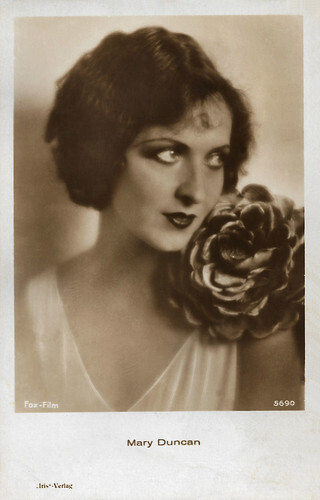
Austrian postcard by Iris Verlag, no. 5690. Photo: Fox-Film.
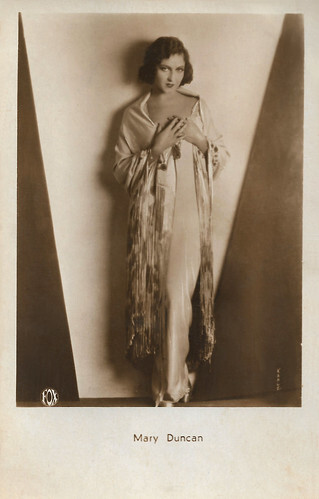
Austrian postcard by Iris Verlag, no. 5883. Photo: Kahle / Fox.
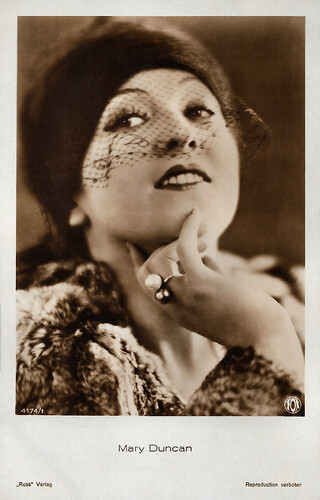
German postcard by Ross Verlag, no. 4174/1, 1929-1930. Photo: Fox-Film.
A controversial smash hit on Broadway
Mary Duncan was born in Luttrellville, Virginia, in 1894. She was the sixth of eight children born to Capt. William S. Duncan and his wife.
Mary attended Cornell University for two years (or one year) before settling on acting as a career. When she left Cornell, she studied acting under French actress Yvette Guilbert .
Duncan began her career as a child actress playing on the Broadway stage in 1910. Her Broadway credits include 'Welcome to Our City' (1919), 'Face Value' (1921), 'The Egotist' (1922), 'New Toys' (1924), 'Human Nature' (1925), and 'All Wet' (1925).
In 1926 she played "Poppy" in the smash hit and controversial play 'The Shanghai Gesture', in which Florence Reed played her mother, known as "Mother Goddam". Reed's character kills her daughter in a startling end to the play. In 1941, the play was turned into a film with Gene Tierney . Critics praised Duncan's acting in the play and she moved to Hollywood.
In 1927, Mary Duncan made her film debut at Fox in the comedy Very Confidential (James Tinling, 1927) starring Madge Bellamy . The following year, she co-starred with Janet Gaynor in the drama 4 Devils/Four Devils (1928), directed by legendary German director F.W. Murnau . For film historians, the film is one of the most wanted lost films. She starred in the partial-talkie drama The River (Frank Borzage, 1929) opposite Charles Farrell . Much of the film has also been lost.
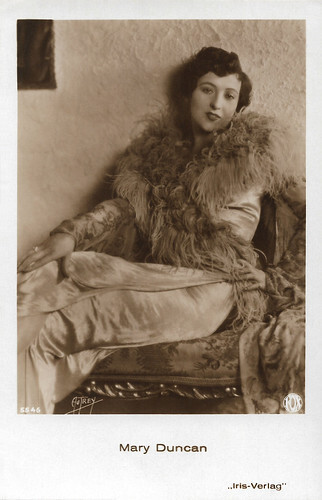
Austrian postcard by Iris Verlag, no. 5546. Photo: Max Munn Autrey / Fox.
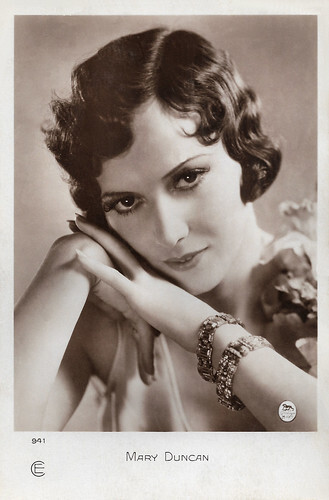
French postcard by Cinémagazine Selection, Paris, no. 941. Photo: Metro-Goldwyn-Mayer.

Italian postcard by G.B. Falci, Milano, no. 398. Photo: Max Munn Autrey / Fox Films Corp. S.A.I.
A bitter memory for everyone concerned
Mary Duncan starred as a Chicago waitress in love with a Minnesota farmer (Charles Farrell) in Murnau's film City Girl (F. W. Murnau, 1930). Murnau shot the film as a silent film in 1928 but City Girl was issued in 1930 in a heavily edited version with awkwardly imposed talking sequences.
What had happened? The Fox Film Studios were subject to a takeover during filming. The new owners requested several changes to City Girl, including the addition of sound sequences which Murnau resisted, and eventually, he walked away to begin filming Tabu, A Story of the South Seas. The sound version of City Girl was released but flopped at the box office and has since been lost.
The MoMA later restored the silent version: "City Girl remained a bitter memory for everyone concerned until the complete silent version was discovered and restored by MoMA, revealing a mature, complex work with a theme that anticipates Murnau’s last masterpiece, Tabu, and lyrical imagery of the plains that influenced Terrence Malick’s Days of Heaven."
After that, Duncan's career hit a lull, according to Wikipedia . In 1931, Florabel Muir wrote in the New York Daily News : "Mary Duncan was in Hollywood nearly all of last year looking for work with little or no luck. She even altered her appearance by having things done to her nose, but still, the producers wouldn't give her a tumble." However, Duncan continued to play substantial parts in films like the romantic comedy The Boudoir Diplomat (Malcolm St. Clair, 1930) with Betty Compson , The Age for Love (Frank Lloyd, 1931) starring Billie Dove , and the drama State's Attorney (George Archainbaud, 1932) starring John Barrymore . Duncan's last film appearance was in Morning Glory (Lowell Sherman, 1933), starring Katharine Hepburn .
In 1933, Duncan married Stephen "Laddie" Sanford, an international polo player and director of the Bigelow-Sanford Carpet Company. After her marriage, she retired from films. They remained married until he died in 1977. She spent much of her remaining years working with several major charities and earned a reputation as a socialite in Palm Beach, Florida. Mary Duncan died in her sleep, aged 98. A niece and great-niece survived her. Duncan was the last known person to have in her possession a copy of the lost Murnau film 4 Devils. Martin Koerber, curator of Deutsche Kinemathek, has speculated that her heirs may still have the valuable print.
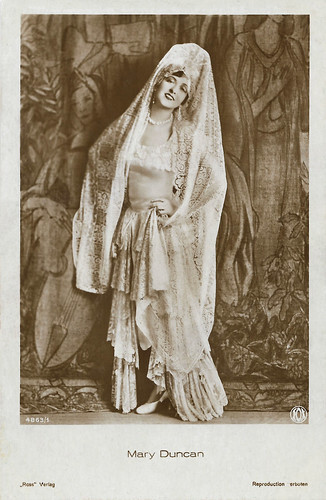
German postcard by Ross Verlag, no. 4863/1, 1929-1930. Photo: Fox. Mary Duncan in Romance of the Rio Grande (Alfred Santell, 1929).
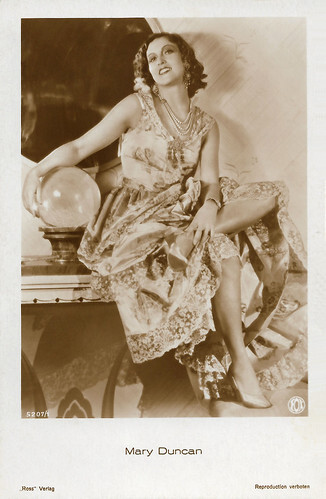
German postcard by Ross Verlag, no. 5207/1, 1930-1931. Photo: Fox.
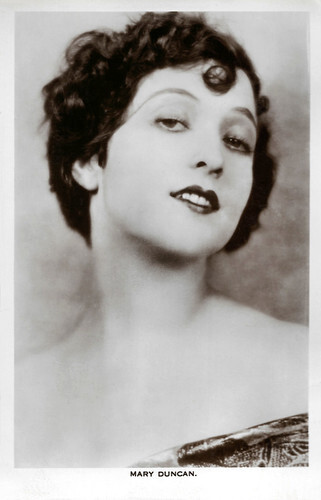
British postcard in the Picturegoer Series, London, no. 442.
Sources: Florabel Muir (Daily News), MoMA, Wikipedia and .

Austrian postcard by Iris Verlag, no. 5690. Photo: Fox-Film.

Austrian postcard by Iris Verlag, no. 5883. Photo: Kahle / Fox.

German postcard by Ross Verlag, no. 4174/1, 1929-1930. Photo: Fox-Film.
A controversial smash hit on Broadway
Mary Duncan was born in Luttrellville, Virginia, in 1894. She was the sixth of eight children born to Capt. William S. Duncan and his wife.
Mary attended Cornell University for two years (or one year) before settling on acting as a career. When she left Cornell, she studied acting under French actress Yvette Guilbert .
Duncan began her career as a child actress playing on the Broadway stage in 1910. Her Broadway credits include 'Welcome to Our City' (1919), 'Face Value' (1921), 'The Egotist' (1922), 'New Toys' (1924), 'Human Nature' (1925), and 'All Wet' (1925).
In 1926 she played "Poppy" in the smash hit and controversial play 'The Shanghai Gesture', in which Florence Reed played her mother, known as "Mother Goddam". Reed's character kills her daughter in a startling end to the play. In 1941, the play was turned into a film with Gene Tierney . Critics praised Duncan's acting in the play and she moved to Hollywood.
In 1927, Mary Duncan made her film debut at Fox in the comedy Very Confidential (James Tinling, 1927) starring Madge Bellamy . The following year, she co-starred with Janet Gaynor in the drama 4 Devils/Four Devils (1928), directed by legendary German director F.W. Murnau . For film historians, the film is one of the most wanted lost films. She starred in the partial-talkie drama The River (Frank Borzage, 1929) opposite Charles Farrell . Much of the film has also been lost.

Austrian postcard by Iris Verlag, no. 5546. Photo: Max Munn Autrey / Fox.

French postcard by Cinémagazine Selection, Paris, no. 941. Photo: Metro-Goldwyn-Mayer.

Italian postcard by G.B. Falci, Milano, no. 398. Photo: Max Munn Autrey / Fox Films Corp. S.A.I.
A bitter memory for everyone concerned
Mary Duncan starred as a Chicago waitress in love with a Minnesota farmer (Charles Farrell) in Murnau's film City Girl (F. W. Murnau, 1930). Murnau shot the film as a silent film in 1928 but City Girl was issued in 1930 in a heavily edited version with awkwardly imposed talking sequences.
What had happened? The Fox Film Studios were subject to a takeover during filming. The new owners requested several changes to City Girl, including the addition of sound sequences which Murnau resisted, and eventually, he walked away to begin filming Tabu, A Story of the South Seas. The sound version of City Girl was released but flopped at the box office and has since been lost.
The MoMA later restored the silent version: "City Girl remained a bitter memory for everyone concerned until the complete silent version was discovered and restored by MoMA, revealing a mature, complex work with a theme that anticipates Murnau’s last masterpiece, Tabu, and lyrical imagery of the plains that influenced Terrence Malick’s Days of Heaven."
After that, Duncan's career hit a lull, according to Wikipedia . In 1931, Florabel Muir wrote in the New York Daily News : "Mary Duncan was in Hollywood nearly all of last year looking for work with little or no luck. She even altered her appearance by having things done to her nose, but still, the producers wouldn't give her a tumble." However, Duncan continued to play substantial parts in films like the romantic comedy The Boudoir Diplomat (Malcolm St. Clair, 1930) with Betty Compson , The Age for Love (Frank Lloyd, 1931) starring Billie Dove , and the drama State's Attorney (George Archainbaud, 1932) starring John Barrymore . Duncan's last film appearance was in Morning Glory (Lowell Sherman, 1933), starring Katharine Hepburn .
In 1933, Duncan married Stephen "Laddie" Sanford, an international polo player and director of the Bigelow-Sanford Carpet Company. After her marriage, she retired from films. They remained married until he died in 1977. She spent much of her remaining years working with several major charities and earned a reputation as a socialite in Palm Beach, Florida. Mary Duncan died in her sleep, aged 98. A niece and great-niece survived her. Duncan was the last known person to have in her possession a copy of the lost Murnau film 4 Devils. Martin Koerber, curator of Deutsche Kinemathek, has speculated that her heirs may still have the valuable print.

German postcard by Ross Verlag, no. 4863/1, 1929-1930. Photo: Fox. Mary Duncan in Romance of the Rio Grande (Alfred Santell, 1929).

German postcard by Ross Verlag, no. 5207/1, 1930-1931. Photo: Fox.

British postcard in the Picturegoer Series, London, no. 442.
Sources: Florabel Muir (Daily News), MoMA, Wikipedia and .
Published on January 28, 2024 22:00
January 27, 2024
Photo by Douglas Kirkland
Douglas Kirkland (1934-2022) was a Canadian-born American photographer who became famous for his film stills and his photos of celebrities. Acclaimed are his pictures of Marilyn Monroe, taken just a year before her death. In the late 1970s, many of his film star photos were used for the Personality series by postcard publishing house Coral-Lee in California.
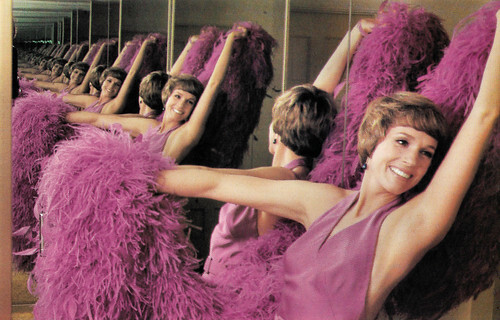
American postcard by Coral-Lee, Rancho Cordova, CA, Personality no. #60/1980. Photo: Douglas Kirkland / Contact, 1980.
English film and stage actress, singer, and author Julie Andrews (1935) was a former child actress and singer who rose to prominence starring in such stage musicals as 'My Fair Lady' and 'Camelot'. She is best known for her roles in the films Mary Poppins (1964) and The Sound of Music (1965). Her voice spanned four octaves until it was damaged by a throat operation in 1997. In the 2000s she had a major revival of her film career in family films such as The Princess Diaries (2001) and the Shrek animated films (2004–2010).
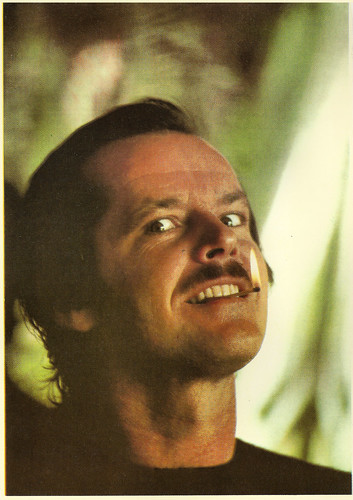
French postcard in the Collection Cinéma Couleur by Editions Le Malibran, Paris, 1989, no. MC 24. Photo: Douglas Kirkland. Caption: Jack Nicholson (1973).
Jack Nicholson (1937) is an American actor and filmmaker who has performed for over sixty years. His rise in Hollywood was far from meteoric, and for years, he sustained his career with guest spots in television series and several Roger Corman films. He is now known for playing a wide range of starring or supporting roles, including satirical comedy, romance, and dark portrayals of anti-heroes and villainous characters. In many of his films, he has played someone who rebels against the social structure. Nicholson's 12 Oscar nominations make him the most nominated male actor ever. He won the Oscars for Best Actor twice – for One Flew Over the Cuckoo's Nest (1975), and As Good as It Gets (1997), and the Oscar for Best Supporting Actor for Terms of Endearment (1983).
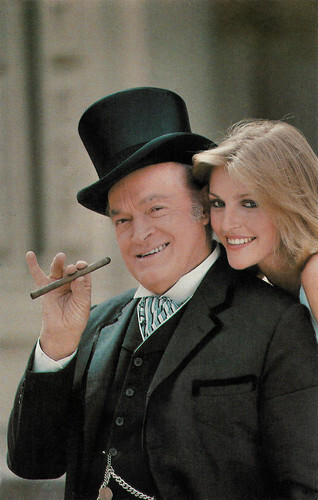
American postcard by Coral-Lee, Rancho Cordova, CA, Personality no. 16. Photo: Douglas Kirkland / 1978 Contact. Caption: Bob Hope - Sardonic, fast-talking TV and Screen genius Bob Hope is not only Mr. Show Business but is probably the all-time world master of a great humor form, the topical one-liner"/ May, 1976.
British-born, American Comedian Bob Hope (1903-2003) started his career that spanned nearly 80 years, onstage as a dancer and comedian. He made his film debut in Paramount Follies (1938) singing 'Thanks for the Memory', which became his signature song. With Bing Crosby and Dorothy Lamour, he appeared in the highly successful Road to ... comedies (1940-1952), and in many other films until the early 1970s. During World War II and the Korean and Vietnam wars he spent much time entertaining the troops in the field. For these activities, he received five honorary Academy Awards.
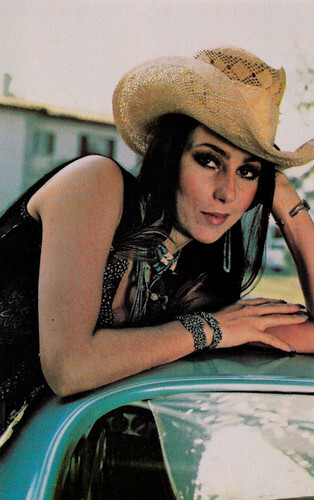
American postcard by Coral-Lee, Rancho Cordova, CA, no. CL/Personality #5 Photo: Douglas Kirkland / Contact, 1977.
Sonny & Cher was an American pop music duo, actors, singers, and entertainers made up of husband-and-wife team Sonny and Cher Bono. They achieved fame with two hit songs in 1965, Baby Don't Go and I Got You Babe. Performing under her first name, Cher (1946) went on to a highly successful career as a solo singer and actress, while Sonny Bono was eventually elected to Congress as a U.S. Representative from California.
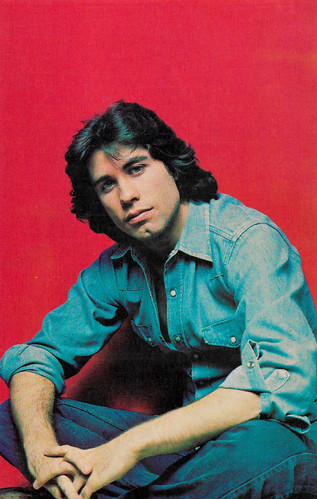
American postcard by Coral-Lee, Rancho Cordova, CA, no. CL/Personality #12. Photo: Douglas Kirkland / Contact, 1977.
John Travolta (1954) is an American actor and singer, who rose to fame during the 1970s, when he appeared on the television sitcom Welcome Back, Kotter (1975-1979), and starred in the box office successes Carrie (1976), Saturday Night Fever (1977), Grease (1978) and Urban Cowboy (1980). His acting career declined throughout the 1980s, but in 1994, Travolta made one of the most stunning comebacks in entertainment history by starring in Quentin Tarantino's Pulp Fiction (1994). Since then he starred in such films as Get Shorty (1995), Face/Off (1997), Primary Colors (1998), and Hairspray (2007). Travolta was nominated for the Academy Award for Best Actor for performances in Saturday Night Fever and Pulp Fiction. In 2016, he received his first Primetime Emmy Award, as a producer of the anthology series American Crime Story in which he also played lawyer Robert Shapiro.
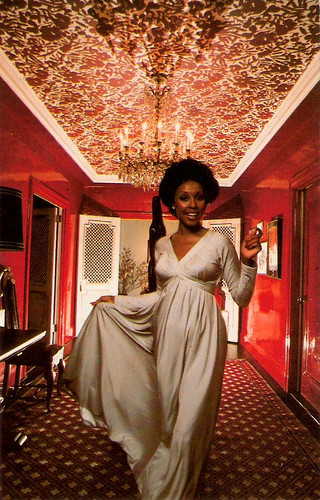
American postcard by Coral-Lee, Rancho Cordova, CA, no. 20. Photo: Douglas Kirkland, 1978. Caption: Diahann Carol (sic) - Star pop singer, was born in New York in 1935. Her career has spanned a multitude of super-successful nightclub, screen and TV engagements.
On 4 October 2019, Diahann Carroll has died aged 84 of cancer. She was among the foremost African-American actors to break down long-seated prejudices in casting. Carroll was the first black performer to have her sitcom, Julia, which ran for 86 episodes (1968-1971), and the first to win an Emmy in the category of Best Actress in a Leading Role in a Comedy Series. She also won a Tony for her performance in the Broadway musical 'No Strings', written especially for her by Richard Rodgers, which highlighted an interracial romance without mentioning colour. Her films included Carmen Jones (1954), Porgy and Bess (1959), Paris Blues (1961) and Claudine (1974). Her conniving and glamorous Dominique Deveraux was a match for Joan Collins’ Alexis Colby, doubling the 'nasty in Dynasty (1984-1997).
A Night with Marilyn
Douglas Morley Kirkland was born in 1934 in Toronto. From the age of three, he grew up near Fort Erie in Ontario where his father ran a small suit store. His dream to become a photographer began while looking at Life magazines his father brought home from that store. He photographed his family and friends. Kirkland moved to the U.S. to attend Seneca Vocational High School in Buffalo, New York and later settled in New York.
He worked at a printing studio in Richmond, Virginia, before spending time as an assistant to photographer Sherwin Greenberg from 1957 to 1958. Kirkland began his career as a photographer at the age of 24 as a staff photographer at the US magazine Look, a large-format glossy magazine with a wide range of subjects that was founded in 1937.
In 1961, Look commissioned him to take photos with Marilyn Monroe for its 25th anniversary issue. The resulting series, 'A Night with Marilyn', which featured Monroe seductively wrapped in white bed sheets, made Kirkland world-famous. In the summer of 1962, also for Look, he produced his series on the then 79-year-old Coco Chanel, whom he accompanied with his camera for three weeks in Paris. During the filming of Cleopatra in 1963, Kirkland went to an interview that Taylor had agreed to give Look magazine in Las Vegas — on the condition there wouldn't be any pictures. Kirkland was sent on the off-chance she would allow him to photograph her. After describing himself as new to the magazine, Kirkland managed to convince Taylor to sit for a few pictures. He described it as the true beginning of his life as a photographer.
As a photojournalist for Look and later Life, Douglas Kirkland reported from Greece, Lebanon and Japan and among his assignments was also fashion work. Kirkland also worked as a photographer on film sets for some major Hollywood films, including The Sound of Music (Robert Wise, 1965) with Julie Andrews, 2001: A Space Odyssey (Stanley Kubrick, 1968) and the Western Butch Cassidy and the Sundance Kid (George Roy Hill, 1969) starring Paul Newman and Robert Redford .
Over time, he portrayed more and more well-known personalities, from Man Ray to Jacques Henri Lartigue and Stephen Hawking. There were also numerous celebrities from the film, show and music business: Elizabeth Taylor , Richard Burton , Audrey Hepburn , Marlene Dietrich , Katharine Hepburn , Judy Garland , Sophia Loren , Bette Davis , Orson Welles , Diana Ross , Michael Jackson , Mick Jagger , John Lennon , and many more.
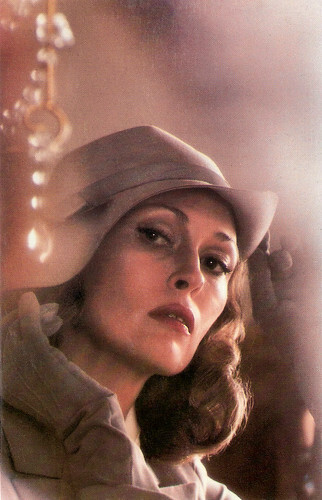
American postcard by Coral-Lee, Rancho Cordova, Ca., no. CL/Personality #22, 1978. Photo: Douglas Kirkland.
American film actress Faye Dunaway (1941) is a classic beauty with high cheekbones and a husky resonant voice. She had her breakthrough as Bonnie Parker in Bonnie and Clyde (1967) and became one of Hollywood's biggest stars of the 1970s with Chinatown (1974), Three Days of the Condor (1975) and Network (1976), for which she won the Oscar.
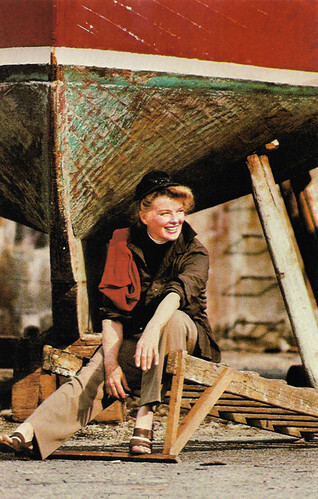
American postcard by Coral-Lee, Rancho Cordova, CA, no. CL/Personality # 130. Photo: Douglas Kirkland.
Katharine Hepburn (1907-2003) was an indomitable American stage and film actress, known as a spirited performer with a touch of eccentricity. She introduced into her roles a strength of character previously considered to be undesirable in Hollywood leading ladies. As an actress, she was noted for her brisk upper-class New England accent and tomboyish beauty.
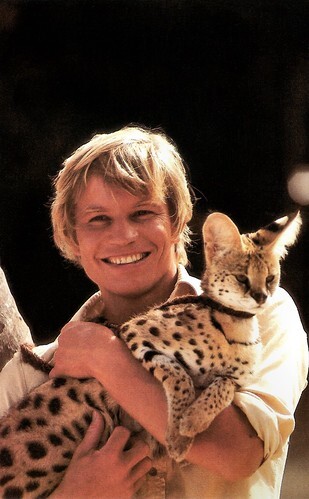
American postcard by Coral-Lee, Rancho Cordova, CA, no. CL/Personality #48-1979. Photo: Douglas Kirkland / Contact.
English actor Michael York (1942) is the athletic star of several Shakespeare adaptations and three popular Musketeer films. His blond, blue-eyed boyish looks and plummy accent incarnated a traditional English public-school manliness in such classic films as Joseph Losey's Accident (1967) and Cabaret (1972).
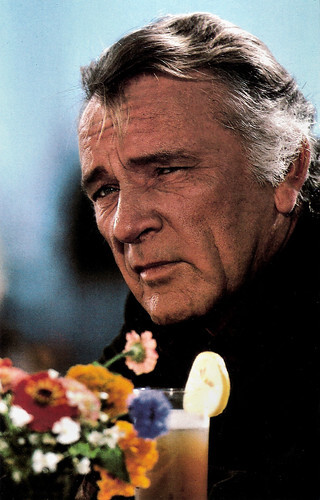
American postcard by Coral-Lee, Rancho Cordova, no. CL/Personality # 71. Photo: Douglas Kirkland, 1981.
Richard Burton (1925–1984) was one of the great British actors of the post-World War II period. Although never trained as an actor, he became famous on stage in most of the plays by William Shakespeare. Blessed with a thrillingly theatrical voice, Burton also became, at one time, the highest-paid film actor in the world. He was nominated seven times for an Academy Award, six of which were for Best Actor in a Leading Role (without ever winning), and was a recipient of BAFTA, Golden Globe and Tony Awards for Best Actor. His adulterous romance with Elizabeth Taylor became an international scandal and their two tempestuous marriages were covered in detail by the paparazzi.
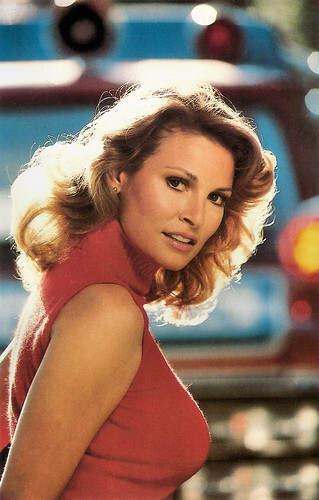
American postcard by Coral-Lee, Rancho Cordova, Ca., no. CL/Personality 21. Photo: Douglas Kirkland, 1978.
American actress Raquel Welch (1940) is one of the icons of the 1960s and 1970s. She first won attention for her role in Fantastic Voyage (1966). In Great Britain, she then made One Million Years B.C. (1966). Although she had only three lines in the film, a poster of Welch in a furry prehistoric bikini became an amazing bestseller and catapulted her to stardom.
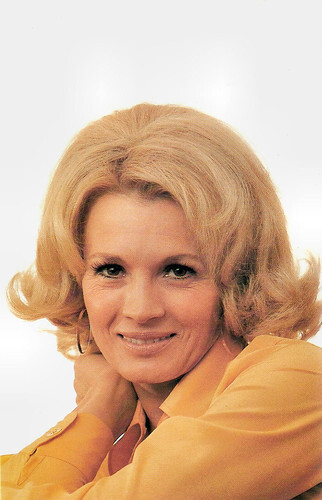
American postcard by Coral-Lee, Rancho Cordova, no. CL/Personality # 52. Photo: Douglas Kirkland, 1980.
American actress Angie Dickinson (1931) has appeared in more than 50 films and starred on television as Sergeant Leann 'Pepper' Anderson in the successful 1970s crime series Police Woman. Her trademarks are her honey blonde hair (on the postcard she still has her original brunette hair colour), her large brown eyes, her voluptuous figure and her deep sultry voice.
Titanic
Douglas Kirkland's portrait of Charlie Chaplin from 1966 is part of the permanent collection of the National Portrait Gallery in London. He is represented with further works in the collection of the Academy of Motion Picture Arts and Sciences in Beverly Hills, which awards the Oscars, in the Smithsonian in Washington D.C., the Houston Centre for Photography, the National Portrait Gallery in Canberra, the Annenberg Space for Photography in Los Angeles and others.
From the mid-1970s, Douglas Kirkland lived in Los Angeles. He worked as a special photographer on over 150 film productions. Later films include Saturday Night Fever (John Badham, 1977) starring John Travolta , Rain Man (Barry Levinson, 1988) with Tom Cruise and Dustin Hoffman , Titanic (James Cameron, 1997), Moulin Rouge! (Baz Luhrmann, 2001), and The Great Gatsby (Baz Luhrmann, 2013) with Leonardo DiCaprio .
Kirkland spent more than forty-five days taking still shots on the set of Titanic (James Cameron, 1997). He and director James Cameron created the picture book 'Titanic' (1998) which was the first book of its kind to reach #1 on the New York Times bestseller list and did so on both the hardcover and paperback lists. Kirkland's next book 'A Life in Pictures' was released in 2013. Douglas Kirkland has taught at the Smithsonian Institution, the AFI Conservatory in Hawaii and Los Angeles, the Art Center College of Design in Pasadena, and the Kodak Centers in Hong Kong, Singapore, and Taiwan.
He received many honours later in life. In 1995, he received the American motion pictures Society of Camera Operators award for his life's work as a still photographer and in 2011 the President's Award of the American Society of Cinematographers. In 2003, he received the Lucie Award in the Achievement in Entertainment category in Los Angeles, which was presented for the first time that year. He received the Nastro D'Argento at the Taormina Film Fest in 2015 and the Outstanding Achievement Award from CAFA, an association of the Canadian fashion industry, in 2019. That year, the documentary film That Click by Luca Severi, which was released at the Festa del Cinema di Roma, honoured him.
Douglas Kirkland died in 2022 at his home in Los Angeles. He was 88. From his first marriage to Marian Perry Wright, he had two daughters, Karen and Lisa, and a son Mark Kirkland, one of the directors of the animated series The Simpsons. He met his second wife Françoise Kemmel-Coulter while in Paris photographing Audrey Hepburn in 1966. They married in 1967 and stayed together until his death.
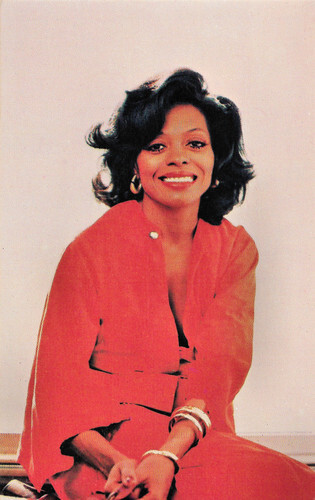
American postcard by Coral-Lee, Rancho Cordova, CA, no. Personality # 4, 1977, no. SC1768. Photo: Douglas Kirkland / Contact.
Diana Ross (1944) is an American soul singer and film actress who became one of the most successful artists in the world. She rose to fame with The Supremes and then launched a successful solo career. She received an Oscar nomination for her debut role as Billie Holiday in the film Lady Sings the Blues (1973). From then on she became a dazzling superstar with such worldwide number-one hits as 'Upside Down', 'I'm Coming Out', and 'Endless Love'.
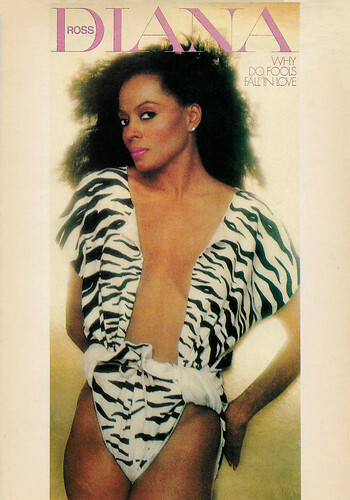
French postcard by Humour à la Carte, Paris, no. A-C 301. Photo: Douglas Kirkland. Diana Ross, cover photo for 'Why Do Fools Fall in Love' (1981).
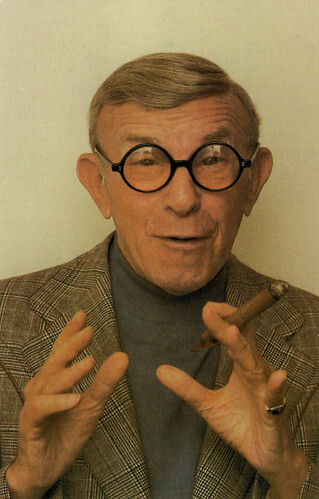
American postcard by Coral-Lee, Rancho Cordova, CA, no. Personality # 14, 1978, no. C32305. Photo: Douglas Kirkland / Contact. Caption: George Burns - Eighty-two-year-old star of "Oh God" still has it all together after a lifetime of success on stage and screen. An immortal still active on this earth! October, 1975.
George Burns (1896-1996) was an American actor, comedian, singer, and published author. He formed a comedy duo with his wife Gracie Allen and typically played the straight man to her zany roles. At the age of 79, Burns won an Academy Award for Best Supporting Actor for The Sunshine Boys (1975) and then played the title role in Oh, God! (1977). The remarkably active, amiable old comedian continued performing until his 90s.
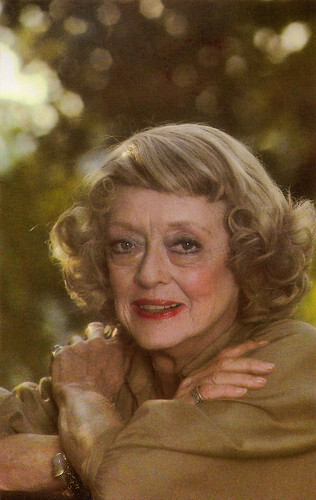
American postcard by Coral-Lee, Rancho Cordova, CA, no. Personality # 89, 1979, no. SC17839. Photo: Douglas Kirkland / Contact.
American film star Bette Davis (1908-1989) was one of the greatest actors in world cinema history. She dared to play unsympathetic, sardonic characters and was reputed for her performances in a range of film genres, from contemporary crime melodramas to historical and period films and occasional comedies. Her greatest successes were her roles in romantic dramas.
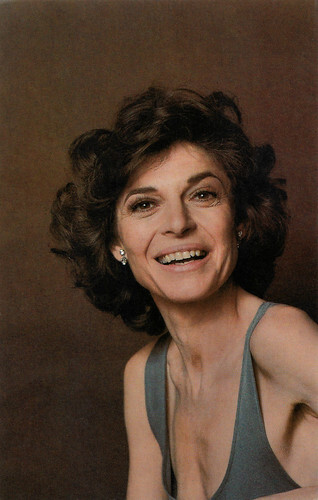
American postcard by Coral-Lee, Rancho Cordova, CA, no. Personality # 18, no. C32309. Photo: Douglas Kirkland. Caption: Anne Bancroft - Star of The Turning Point and other stage and cinematic successes. Ms. Bancroft is the wife of actor-writer-producer-comic Mel Brooks, October 1976.
Anne Bancroft (1931-2005) was an American stage and film actress. She made her breakthrough with the general public with her role as Mrs. Robinson in The Graduate (1967). She also appeared in several films directed or produced by her husband, Mel Brooks.
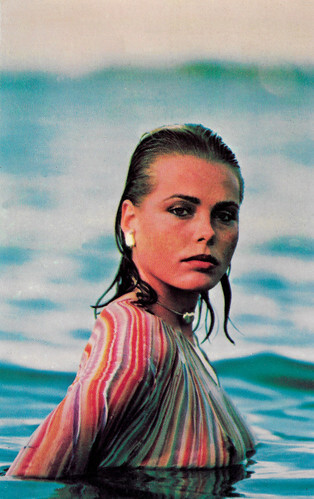
American postcard by Coral-Lee, Rancho Cordova, CA, no. Personality # 11, 1977, no. C31775. Photo: Douglas Kirkland / Contact.
American model and actress Margaux Hemingway (1954-1996) was the granddaughter of author Ernest Hemingway. She gained success as a supermodel in the mid-1970s and later starred in several films.
Sources: Jackson Weaver (CBC News), National Portrait Gallery, Wikipedia (German, French and English) and .

American postcard by Coral-Lee, Rancho Cordova, CA, Personality no. #60/1980. Photo: Douglas Kirkland / Contact, 1980.
English film and stage actress, singer, and author Julie Andrews (1935) was a former child actress and singer who rose to prominence starring in such stage musicals as 'My Fair Lady' and 'Camelot'. She is best known for her roles in the films Mary Poppins (1964) and The Sound of Music (1965). Her voice spanned four octaves until it was damaged by a throat operation in 1997. In the 2000s she had a major revival of her film career in family films such as The Princess Diaries (2001) and the Shrek animated films (2004–2010).

French postcard in the Collection Cinéma Couleur by Editions Le Malibran, Paris, 1989, no. MC 24. Photo: Douglas Kirkland. Caption: Jack Nicholson (1973).
Jack Nicholson (1937) is an American actor and filmmaker who has performed for over sixty years. His rise in Hollywood was far from meteoric, and for years, he sustained his career with guest spots in television series and several Roger Corman films. He is now known for playing a wide range of starring or supporting roles, including satirical comedy, romance, and dark portrayals of anti-heroes and villainous characters. In many of his films, he has played someone who rebels against the social structure. Nicholson's 12 Oscar nominations make him the most nominated male actor ever. He won the Oscars for Best Actor twice – for One Flew Over the Cuckoo's Nest (1975), and As Good as It Gets (1997), and the Oscar for Best Supporting Actor for Terms of Endearment (1983).

American postcard by Coral-Lee, Rancho Cordova, CA, Personality no. 16. Photo: Douglas Kirkland / 1978 Contact. Caption: Bob Hope - Sardonic, fast-talking TV and Screen genius Bob Hope is not only Mr. Show Business but is probably the all-time world master of a great humor form, the topical one-liner"/ May, 1976.
British-born, American Comedian Bob Hope (1903-2003) started his career that spanned nearly 80 years, onstage as a dancer and comedian. He made his film debut in Paramount Follies (1938) singing 'Thanks for the Memory', which became his signature song. With Bing Crosby and Dorothy Lamour, he appeared in the highly successful Road to ... comedies (1940-1952), and in many other films until the early 1970s. During World War II and the Korean and Vietnam wars he spent much time entertaining the troops in the field. For these activities, he received five honorary Academy Awards.

American postcard by Coral-Lee, Rancho Cordova, CA, no. CL/Personality #5 Photo: Douglas Kirkland / Contact, 1977.
Sonny & Cher was an American pop music duo, actors, singers, and entertainers made up of husband-and-wife team Sonny and Cher Bono. They achieved fame with two hit songs in 1965, Baby Don't Go and I Got You Babe. Performing under her first name, Cher (1946) went on to a highly successful career as a solo singer and actress, while Sonny Bono was eventually elected to Congress as a U.S. Representative from California.

American postcard by Coral-Lee, Rancho Cordova, CA, no. CL/Personality #12. Photo: Douglas Kirkland / Contact, 1977.
John Travolta (1954) is an American actor and singer, who rose to fame during the 1970s, when he appeared on the television sitcom Welcome Back, Kotter (1975-1979), and starred in the box office successes Carrie (1976), Saturday Night Fever (1977), Grease (1978) and Urban Cowboy (1980). His acting career declined throughout the 1980s, but in 1994, Travolta made one of the most stunning comebacks in entertainment history by starring in Quentin Tarantino's Pulp Fiction (1994). Since then he starred in such films as Get Shorty (1995), Face/Off (1997), Primary Colors (1998), and Hairspray (2007). Travolta was nominated for the Academy Award for Best Actor for performances in Saturday Night Fever and Pulp Fiction. In 2016, he received his first Primetime Emmy Award, as a producer of the anthology series American Crime Story in which he also played lawyer Robert Shapiro.

American postcard by Coral-Lee, Rancho Cordova, CA, no. 20. Photo: Douglas Kirkland, 1978. Caption: Diahann Carol (sic) - Star pop singer, was born in New York in 1935. Her career has spanned a multitude of super-successful nightclub, screen and TV engagements.
On 4 October 2019, Diahann Carroll has died aged 84 of cancer. She was among the foremost African-American actors to break down long-seated prejudices in casting. Carroll was the first black performer to have her sitcom, Julia, which ran for 86 episodes (1968-1971), and the first to win an Emmy in the category of Best Actress in a Leading Role in a Comedy Series. She also won a Tony for her performance in the Broadway musical 'No Strings', written especially for her by Richard Rodgers, which highlighted an interracial romance without mentioning colour. Her films included Carmen Jones (1954), Porgy and Bess (1959), Paris Blues (1961) and Claudine (1974). Her conniving and glamorous Dominique Deveraux was a match for Joan Collins’ Alexis Colby, doubling the 'nasty in Dynasty (1984-1997).
A Night with Marilyn
Douglas Morley Kirkland was born in 1934 in Toronto. From the age of three, he grew up near Fort Erie in Ontario where his father ran a small suit store. His dream to become a photographer began while looking at Life magazines his father brought home from that store. He photographed his family and friends. Kirkland moved to the U.S. to attend Seneca Vocational High School in Buffalo, New York and later settled in New York.
He worked at a printing studio in Richmond, Virginia, before spending time as an assistant to photographer Sherwin Greenberg from 1957 to 1958. Kirkland began his career as a photographer at the age of 24 as a staff photographer at the US magazine Look, a large-format glossy magazine with a wide range of subjects that was founded in 1937.
In 1961, Look commissioned him to take photos with Marilyn Monroe for its 25th anniversary issue. The resulting series, 'A Night with Marilyn', which featured Monroe seductively wrapped in white bed sheets, made Kirkland world-famous. In the summer of 1962, also for Look, he produced his series on the then 79-year-old Coco Chanel, whom he accompanied with his camera for three weeks in Paris. During the filming of Cleopatra in 1963, Kirkland went to an interview that Taylor had agreed to give Look magazine in Las Vegas — on the condition there wouldn't be any pictures. Kirkland was sent on the off-chance she would allow him to photograph her. After describing himself as new to the magazine, Kirkland managed to convince Taylor to sit for a few pictures. He described it as the true beginning of his life as a photographer.
As a photojournalist for Look and later Life, Douglas Kirkland reported from Greece, Lebanon and Japan and among his assignments was also fashion work. Kirkland also worked as a photographer on film sets for some major Hollywood films, including The Sound of Music (Robert Wise, 1965) with Julie Andrews, 2001: A Space Odyssey (Stanley Kubrick, 1968) and the Western Butch Cassidy and the Sundance Kid (George Roy Hill, 1969) starring Paul Newman and Robert Redford .
Over time, he portrayed more and more well-known personalities, from Man Ray to Jacques Henri Lartigue and Stephen Hawking. There were also numerous celebrities from the film, show and music business: Elizabeth Taylor , Richard Burton , Audrey Hepburn , Marlene Dietrich , Katharine Hepburn , Judy Garland , Sophia Loren , Bette Davis , Orson Welles , Diana Ross , Michael Jackson , Mick Jagger , John Lennon , and many more.

American postcard by Coral-Lee, Rancho Cordova, Ca., no. CL/Personality #22, 1978. Photo: Douglas Kirkland.
American film actress Faye Dunaway (1941) is a classic beauty with high cheekbones and a husky resonant voice. She had her breakthrough as Bonnie Parker in Bonnie and Clyde (1967) and became one of Hollywood's biggest stars of the 1970s with Chinatown (1974), Three Days of the Condor (1975) and Network (1976), for which she won the Oscar.

American postcard by Coral-Lee, Rancho Cordova, CA, no. CL/Personality # 130. Photo: Douglas Kirkland.
Katharine Hepburn (1907-2003) was an indomitable American stage and film actress, known as a spirited performer with a touch of eccentricity. She introduced into her roles a strength of character previously considered to be undesirable in Hollywood leading ladies. As an actress, she was noted for her brisk upper-class New England accent and tomboyish beauty.

American postcard by Coral-Lee, Rancho Cordova, CA, no. CL/Personality #48-1979. Photo: Douglas Kirkland / Contact.
English actor Michael York (1942) is the athletic star of several Shakespeare adaptations and three popular Musketeer films. His blond, blue-eyed boyish looks and plummy accent incarnated a traditional English public-school manliness in such classic films as Joseph Losey's Accident (1967) and Cabaret (1972).

American postcard by Coral-Lee, Rancho Cordova, no. CL/Personality # 71. Photo: Douglas Kirkland, 1981.
Richard Burton (1925–1984) was one of the great British actors of the post-World War II period. Although never trained as an actor, he became famous on stage in most of the plays by William Shakespeare. Blessed with a thrillingly theatrical voice, Burton also became, at one time, the highest-paid film actor in the world. He was nominated seven times for an Academy Award, six of which were for Best Actor in a Leading Role (without ever winning), and was a recipient of BAFTA, Golden Globe and Tony Awards for Best Actor. His adulterous romance with Elizabeth Taylor became an international scandal and their two tempestuous marriages were covered in detail by the paparazzi.

American postcard by Coral-Lee, Rancho Cordova, Ca., no. CL/Personality 21. Photo: Douglas Kirkland, 1978.
American actress Raquel Welch (1940) is one of the icons of the 1960s and 1970s. She first won attention for her role in Fantastic Voyage (1966). In Great Britain, she then made One Million Years B.C. (1966). Although she had only three lines in the film, a poster of Welch in a furry prehistoric bikini became an amazing bestseller and catapulted her to stardom.

American postcard by Coral-Lee, Rancho Cordova, no. CL/Personality # 52. Photo: Douglas Kirkland, 1980.
American actress Angie Dickinson (1931) has appeared in more than 50 films and starred on television as Sergeant Leann 'Pepper' Anderson in the successful 1970s crime series Police Woman. Her trademarks are her honey blonde hair (on the postcard she still has her original brunette hair colour), her large brown eyes, her voluptuous figure and her deep sultry voice.
Titanic
Douglas Kirkland's portrait of Charlie Chaplin from 1966 is part of the permanent collection of the National Portrait Gallery in London. He is represented with further works in the collection of the Academy of Motion Picture Arts and Sciences in Beverly Hills, which awards the Oscars, in the Smithsonian in Washington D.C., the Houston Centre for Photography, the National Portrait Gallery in Canberra, the Annenberg Space for Photography in Los Angeles and others.
From the mid-1970s, Douglas Kirkland lived in Los Angeles. He worked as a special photographer on over 150 film productions. Later films include Saturday Night Fever (John Badham, 1977) starring John Travolta , Rain Man (Barry Levinson, 1988) with Tom Cruise and Dustin Hoffman , Titanic (James Cameron, 1997), Moulin Rouge! (Baz Luhrmann, 2001), and The Great Gatsby (Baz Luhrmann, 2013) with Leonardo DiCaprio .
Kirkland spent more than forty-five days taking still shots on the set of Titanic (James Cameron, 1997). He and director James Cameron created the picture book 'Titanic' (1998) which was the first book of its kind to reach #1 on the New York Times bestseller list and did so on both the hardcover and paperback lists. Kirkland's next book 'A Life in Pictures' was released in 2013. Douglas Kirkland has taught at the Smithsonian Institution, the AFI Conservatory in Hawaii and Los Angeles, the Art Center College of Design in Pasadena, and the Kodak Centers in Hong Kong, Singapore, and Taiwan.
He received many honours later in life. In 1995, he received the American motion pictures Society of Camera Operators award for his life's work as a still photographer and in 2011 the President's Award of the American Society of Cinematographers. In 2003, he received the Lucie Award in the Achievement in Entertainment category in Los Angeles, which was presented for the first time that year. He received the Nastro D'Argento at the Taormina Film Fest in 2015 and the Outstanding Achievement Award from CAFA, an association of the Canadian fashion industry, in 2019. That year, the documentary film That Click by Luca Severi, which was released at the Festa del Cinema di Roma, honoured him.
Douglas Kirkland died in 2022 at his home in Los Angeles. He was 88. From his first marriage to Marian Perry Wright, he had two daughters, Karen and Lisa, and a son Mark Kirkland, one of the directors of the animated series The Simpsons. He met his second wife Françoise Kemmel-Coulter while in Paris photographing Audrey Hepburn in 1966. They married in 1967 and stayed together until his death.

American postcard by Coral-Lee, Rancho Cordova, CA, no. Personality # 4, 1977, no. SC1768. Photo: Douglas Kirkland / Contact.
Diana Ross (1944) is an American soul singer and film actress who became one of the most successful artists in the world. She rose to fame with The Supremes and then launched a successful solo career. She received an Oscar nomination for her debut role as Billie Holiday in the film Lady Sings the Blues (1973). From then on she became a dazzling superstar with such worldwide number-one hits as 'Upside Down', 'I'm Coming Out', and 'Endless Love'.

French postcard by Humour à la Carte, Paris, no. A-C 301. Photo: Douglas Kirkland. Diana Ross, cover photo for 'Why Do Fools Fall in Love' (1981).

American postcard by Coral-Lee, Rancho Cordova, CA, no. Personality # 14, 1978, no. C32305. Photo: Douglas Kirkland / Contact. Caption: George Burns - Eighty-two-year-old star of "Oh God" still has it all together after a lifetime of success on stage and screen. An immortal still active on this earth! October, 1975.
George Burns (1896-1996) was an American actor, comedian, singer, and published author. He formed a comedy duo with his wife Gracie Allen and typically played the straight man to her zany roles. At the age of 79, Burns won an Academy Award for Best Supporting Actor for The Sunshine Boys (1975) and then played the title role in Oh, God! (1977). The remarkably active, amiable old comedian continued performing until his 90s.

American postcard by Coral-Lee, Rancho Cordova, CA, no. Personality # 89, 1979, no. SC17839. Photo: Douglas Kirkland / Contact.
American film star Bette Davis (1908-1989) was one of the greatest actors in world cinema history. She dared to play unsympathetic, sardonic characters and was reputed for her performances in a range of film genres, from contemporary crime melodramas to historical and period films and occasional comedies. Her greatest successes were her roles in romantic dramas.

American postcard by Coral-Lee, Rancho Cordova, CA, no. Personality # 18, no. C32309. Photo: Douglas Kirkland. Caption: Anne Bancroft - Star of The Turning Point and other stage and cinematic successes. Ms. Bancroft is the wife of actor-writer-producer-comic Mel Brooks, October 1976.
Anne Bancroft (1931-2005) was an American stage and film actress. She made her breakthrough with the general public with her role as Mrs. Robinson in The Graduate (1967). She also appeared in several films directed or produced by her husband, Mel Brooks.

American postcard by Coral-Lee, Rancho Cordova, CA, no. Personality # 11, 1977, no. C31775. Photo: Douglas Kirkland / Contact.
American model and actress Margaux Hemingway (1954-1996) was the granddaughter of author Ernest Hemingway. She gained success as a supermodel in the mid-1970s and later starred in several films.
Sources: Jackson Weaver (CBC News), National Portrait Gallery, Wikipedia (German, French and English) and .
Published on January 27, 2024 22:00
Paul van Yperen's Blog
- Paul van Yperen's profile
- 13 followers
Paul van Yperen isn't a Goodreads Author
(yet),
but they
do have a blog,
so here are some recent posts imported from
their feed.



